The Unlimited class of the '70s saw some outrageous bikes battling it out, one of those was the Hadleigh Honda 750. AC gives us the ride impression and full history... Photos:Kel Edge
Britain’s 1970s short circuit racing scene saw fans enthralled by the no-prisoners warfare in the 501-1000cc Unlimited class races between a huge variety of different motorcycles. How can we forget the fastest of the fours, Julian Soper’s Hadleigh Honda 750…
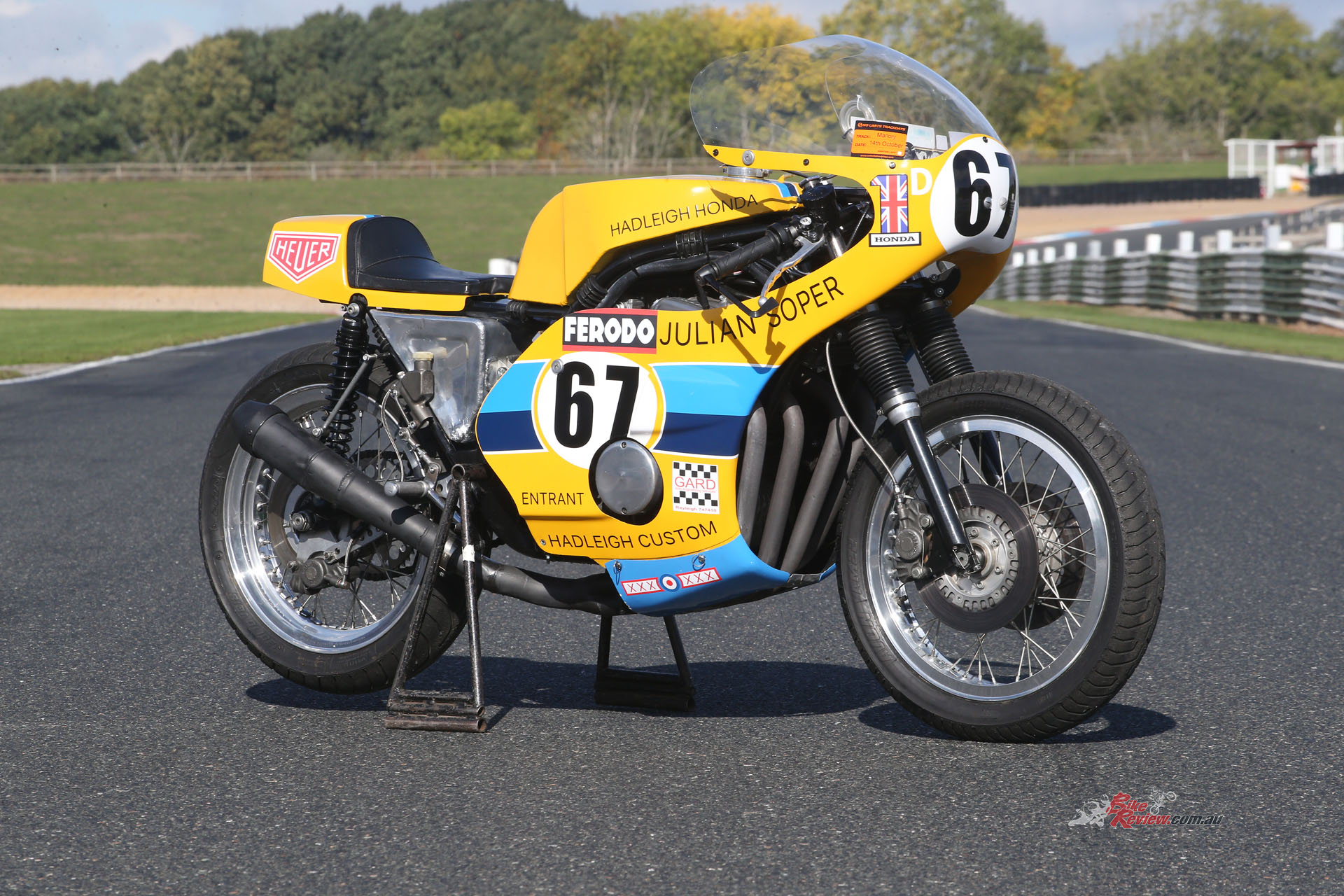
Britain’s 1970s short circuit racing scene saw fans enthralled by the no-prisoners warfare in the 501-1000cc Unlimited class. How can we forget the fastest of the fours, Julian Soper’s Hadleigh Honda 750..
The Unlimited class pitted riders against four-time Bemsee Club champion Lance Capon – the last such title, in 1975, tragically awarded to him posthumously – on his brutally effective one-litre Vincent Special. Other incredible bikes included P&M founder Richard Peckett’s melodic Dresda-framed RPS Triumph triple, Chris Emmins’ fearsome 850cc Weslake, Dave Camier’s and Mike Shoesmith’s thunderous Norton twins – and as ultra-distinctive as ever thanks to its rider’s trademark striped helmet, the howling Hadleigh Honda four of Julian Soper.
Check out our other Throwback Thursdays here…
The 1970s was a key crossover era for the British short circuit scene, which until then had catered exclusively for GP racing classes from 50cc to 500cc, with Production races and Sidecar scraps added in by way of contrast. But already by 1971 the 501-1,000cc Unlimited class was gaining momentum and more importantly spectator approval, coinciding with the development of Formula 750 on the other side of the Atlantic, soon to be exported to Europe.
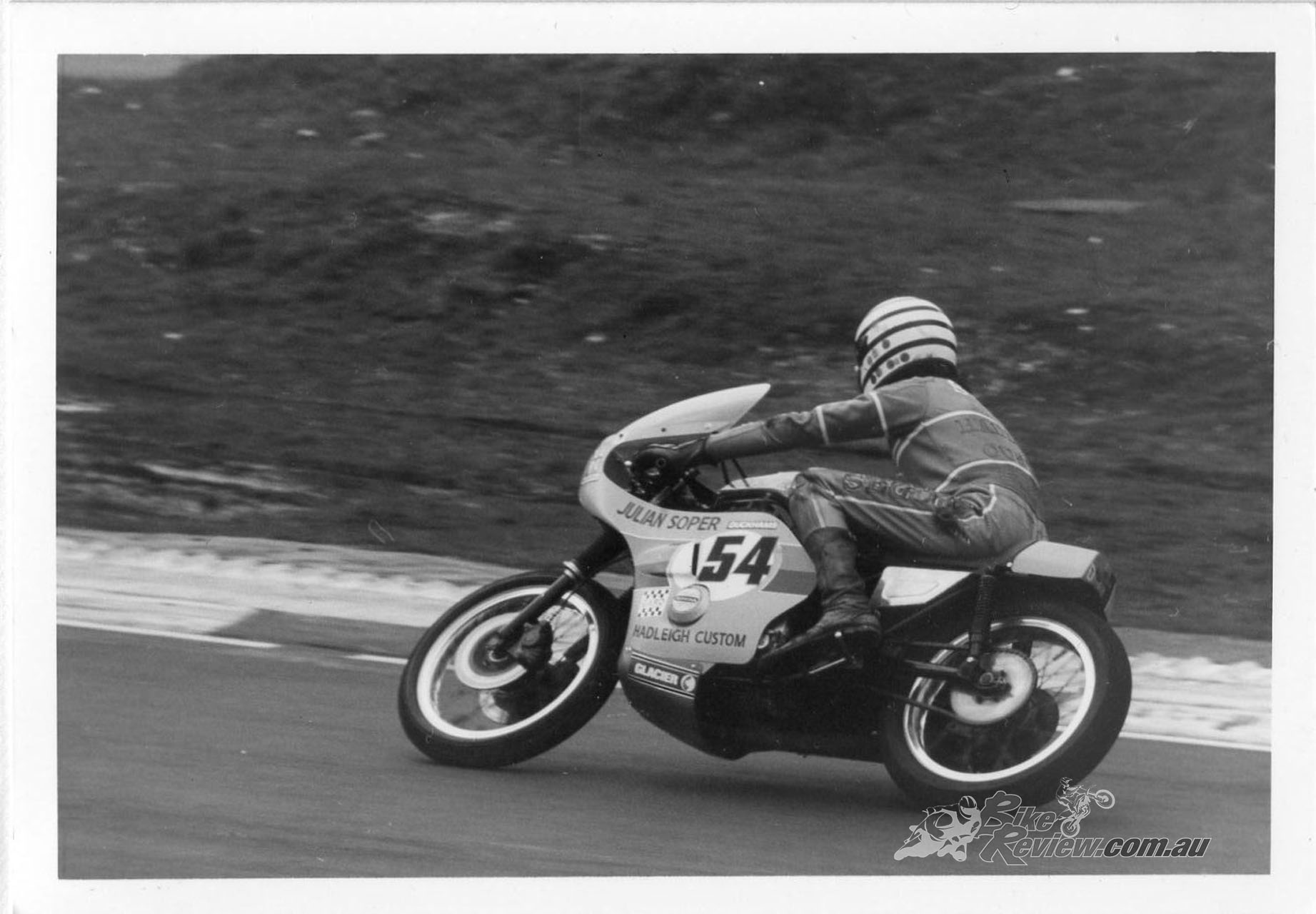
The 1970s was a key crossover era for the British short circuit scene, which until then had catered exclusively for GP racing classes from 50cc to 500cc, with Production races and Sidecar scraps added in by way of contrast.
This led to the likes of Colin Seeley publicly complaining to the powers-that-be about the downgrading of the 500cc blue riband class – but it was too late: that fox had been shot, and the 1970-72 development of the Rob North-framed works BSA/Triumph triple and its Seeley-framed Boyer Triumph rival, the John Player Norton parallel-twin and the iconic Harley-Davidson XR-TT and desmo Ducati V-twins fuelled the public’s appetite for big bike racing, as one of road racing’s several early-‘70s turns of the tide.
Another tide-turner was the concurrent arrival of big Japanese two-strokes in F750, starting with the TR750 Suzuki and H2R Kawasaki triples in 1973, before the bike offering the most performance for the least money that the motorcycle world is ever likely to see, the Yamaha TZ750, made its stunning debut on the world stage in the hands of Giacomo Agostini, with his fairytale victory in the March 1974 Daytona 200 – his first-ever race on a two-stroke. But one manufacturer was absent from the grids, despite having won the 1969 Bol d’Or 24 Hours on its CB750 four’s competition debut, and then the 1970 Daytona 200: Honda.
Honda had introduced the modern era of streetbikes with the CB750’s 1969 unveiling – but after its tricked-out CR750’s winning Daytona debut renounced all road racing with that model on an official basis, leaving its customers around the world to do the job for it. Only one thing wrong: the stock Honda frame was quite unsuited to the race track, when combined with the increased grip of even treaded race tyres in that pre-slicks era. As Cycle World magazine wrote in its July 1974 issue, “Don’t sell that monstrous four-banger just because it wiggles like a wounded snake every time you think about tilting it from a vertical plane!”
The solution was instead to purchase a properly designed, well-built bespoke chassis from a European frame specialist like Egli, Dresda, Rickman, Segale, Martin, Bimota etc. and stick the undoubtedly capable when suitably tuned up Honda motor in it. The potential market for such a bike was what persuaded Stan Shenton, MD of the huge Boyer’s of Bromley Triumph dealership in the Southeast London suburbs, to consider adapting the factory-developed Rob North F750 frame which the Midlands tube-bender had created in 1970 for the BSA/Triumph triple motors, to accommodate the four-cylinder Honda engine.
To go Formula 750 racing with a BSA/Triumph triple after the category was imported to Europe from the USA in 1971, history dictates that the only way to do so was with a Rob North race frame. But Stan Shenton, had other ideas, which have been all but airbrushed from history. Although as one of Honda’s top UK dealers, he’d receive early supplies of the Triumph’s great rival, his heart was in Triumphs, whereas the Honda was business.
“Our modified Trident T150 production racers often beat the works team’s, which didn’t always please the Triumph factory!” says Stan, today a spry 95 years young. “Our Boyer Trident won the 1970 Shell Oils ACU 750cc Production Championship ridden by David Nixon, so I decided to move up a category for 1971, by going open-class Formula 750 racing. Attempts to persuade Triumph to supply us with one of the frames Rob North made exclusively for them came to nought, so I approached Colin Seeley to create a purpose-built chassis for the Boyer Triumph F750 contender, which he did.”
Dave Nixon enjoyed lots of success during 1972-73 with the Seeley-framed Boyer Triumph, sharing the all-time lap record for the Crystal Palace circuit in winning the last race ever held there in August 1972, and the Boyer Triumphs often had the beating of the factory triples.
“We had very good bikes – so much so that the factory changed its mind and said we could have Rob North frames after all!” says Shenton, who nevertheless stayed faithful to his Seeley-framed bikes. But after the September 1973 announcement that Triumph’s Meriden factory was closing down, Shenton stepped in to acquire the Rob North chassis project in its entirety for Boyer, intending to use it with other engines. The unique Rob North-framed Hadleigh Honda later raced so successfully by Julian Soper was however the only such bike built with a Japanese four-cylinder motor squeezed into the space Rob North had left for a triple, exactly 50 years ago in 1973.
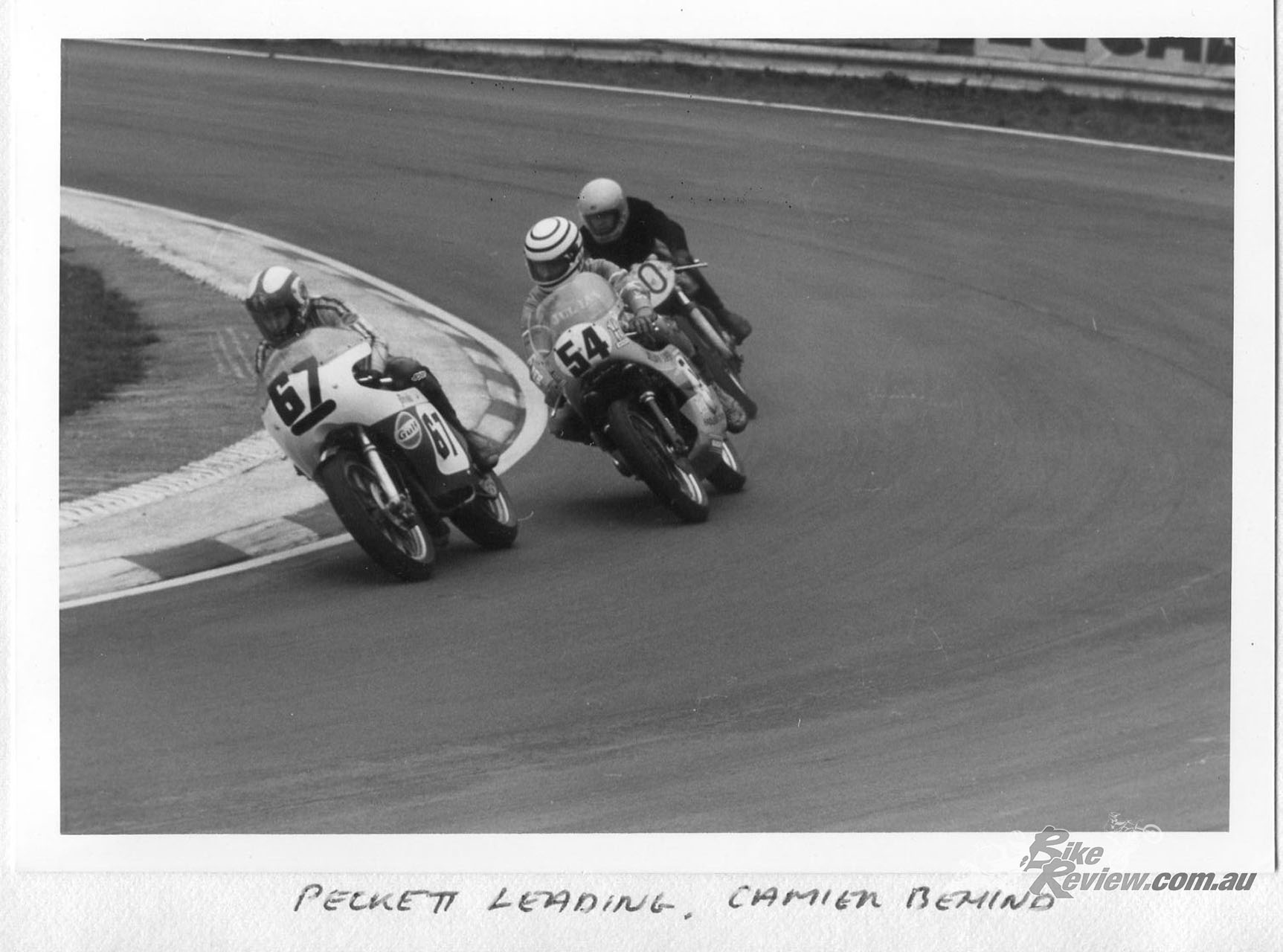
First meeting on the Rob North Honda. Chasing Richard Peckett on a Dresda Honda ahead of Dave Camier.
For Boyer was by now also a Kawasaki main dealer, so when Shenton was asked to take over running the official UK Kawasaki race team for 1974, he sold the entire Rob North frame package complete with chassis jigs and moulds for its trademark letter-box fairing to Norman Miles, who’d been manufacturing components for the Boyer Bransden electronic ignitions.
The Boyer team directed its tuning talents in future towards Team Green and Kawasaki, so the Rob North Honda project died a death, and the single partly-completed bike made ended up at Piper Cams in Ashford, Kent, whose technical director Bob Gayler had assisted Shenton in tuning the Boyer Triumph motors so successfully. The duo had intended doing a similar number on the CB750 Honda engine, but that was aborted by Shenton’s Kawasaki deal.
Enter Julian, a Welsh-born motorcycle mechanic living in Southend who’d started racing in 1970 aged 22 aboard a 650 Triton he’d acquired from Geoff Monty. Julian passed away in December 2021, but fortunately not before I’d had the chance to talk with him about the Hadleigh Honda.
“My boss Dave Bexley owned Hadleigh Custom, which was a motorcycle dealership in Westcliffe-on-Sea, Essex,” he told me, “and he was racing a Honda sidecar with an engine he was developing himself. I’d moved on from the Triton in ’73 and bought a 350cc TR2B Yamaha, thinking that was the way forward, but it was unreliable and a backward step, with just five wins in total that season. So in ‘74 I used a Honda engine in a Dresda frame, but the handling was a bit iffy – not at all confidence inspiring.”
“Then one day that winter I was at Piper Cams picking up some goods for the shop, and there in the corner was the Rob North Honda with no engine, only the cycle parts basically just lying around. So I asked what it was, and was told “Oh, just an unfinished project”. So I asked how much it was to buy. “£600”. I said “Really?” because Rob North was a well-known name. So I bought it, stuck my Honda engine in it and raced it for two full seasons in 1975-76. It really worked very well for me, and certainly helped put me on the map.”
That’s quite an understatement from a man so modest that his two teenage children had no idea he’d ever raced motorcycles, let alone so successfully, until he brought them along to a 2009 Brands Hatch BSB round where he was to be reunited with the Hadleigh Honda for the first time in over 30 years, and got writer’s cramp signing autographs. But having a supportive boss who was already adept at tuning Honda engines gave Julian a head start in transforming this throwaway project into a super-competitive racer.
With British short circuit racing’s premier 1975 MCN Superbike Championship’s hitherto 750cc top limit for four-strokes pushed out to 1,000cc to encourage more such crowd-pleasing bikes to compete against the 750cc two-strokes already dominating the grid, the Hadleigh Honda’s stock SOHC 736cc CB750K2 engine measuring 61 x 63 mm was bored out to 67 x 63 mm dimensions for 888cc via a Dunstall big bore kit.
“We also had a factory crankshaft, which we used as a template to modify the road crank to factory spec,” said Julian. “We lost at least ten pounds from it, and that made it rev a lot easier, plus it was much crisper. We also had an RSC factory ignition, which still used points but with a slim generator on the opposite side.” The Hadleigh-tuned engine retained the stock conrods, but was fitted with several Yoshimura tuning parts including a camchain and tensioners, a high-lift Daytona camshaft and a close-ratio five-speed gearbox, plus heavy duty springs for the standard clutch, and dual S&W valve springs on the stock valves.
The cylinder head was ported and flowed, while Soper experimented with a mix of carbs. “I tried various carburettors, Mark 1 and Mark 2 Amal Concentrics, the standard 28mm Keihin PD carbs, and also the CR Keihins which made it very top-endy, but most of the time I used the Mark 2 Amals,” said Julian. Despite eight race wins in 1974 using the Dresda frame, including a trio of victories at a Snetterton National, Soper wasn’t happy with the way the Dresda steered, so having acquired the Rob North frame he simply squeezed the same big bore motor in it for 1975, then marked a successful debut with the result with a pair each of seconds and thirds in the opening meeting of the season at Brands Hatch.
This was Julian Soper’s breakthrough year on the British stage, with copious wins and places at Club and National level on the Hadleigh Honda, which might have been more had he not had to grapple with the dead-engine pushstarts to such short races which curiously still persisted back then even in the Unlimited class – quite a hurdle with the big four-strokes, even for someone of Julian’s 188cm stature. Hence the reason by the way for him to jettison the Rob North frame’s trademark letterbox fairing in favour of TZ750 aftermarket bodywork, which gave him more space to tuck his lanky build behind the screen.
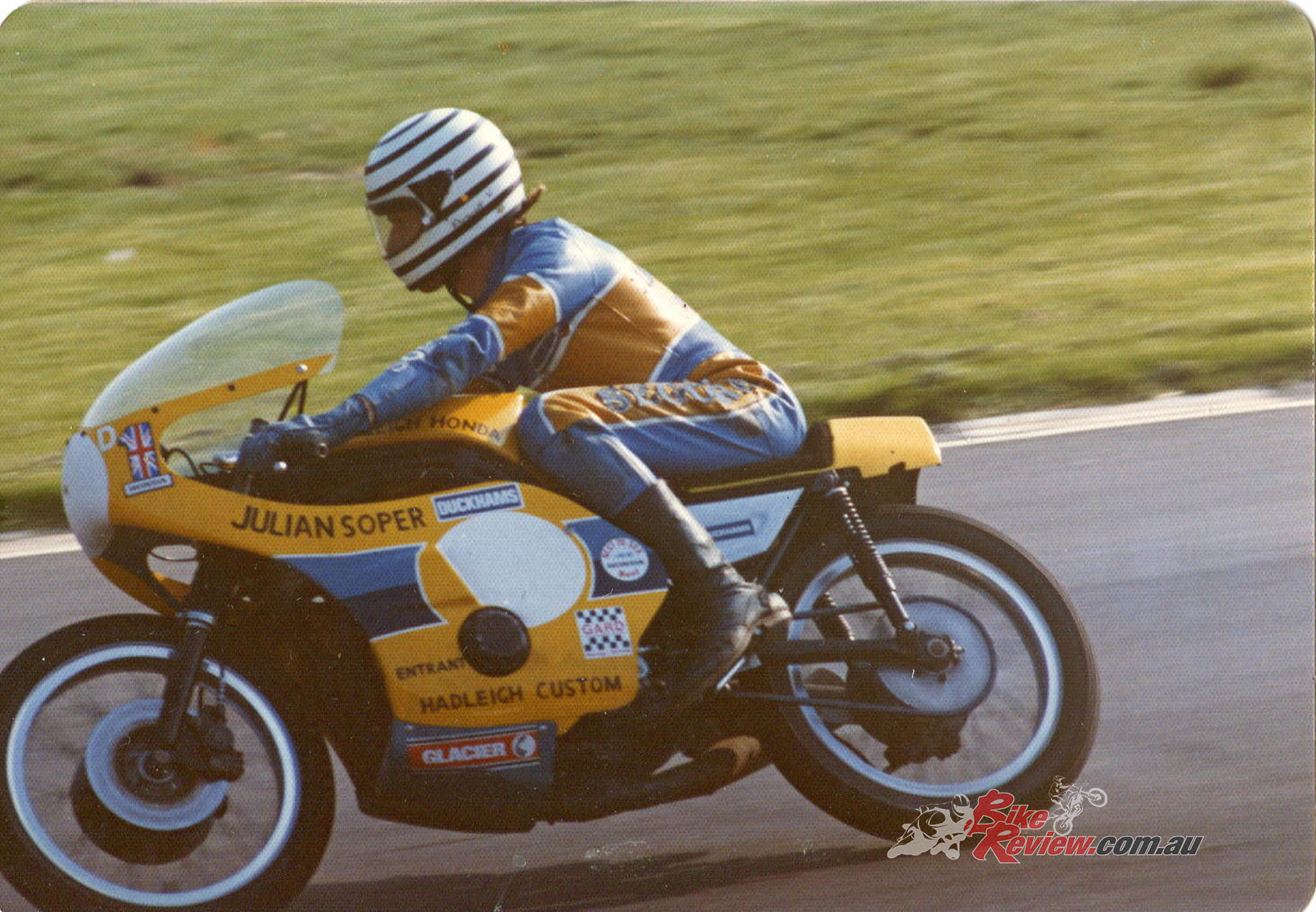
Soper was a tall bloke. The team opted for TZ750 aftermarket bodywork, which gave him more space to tuck his lanky build behind the screen.
The Hadleigh Honda’s successful debut season included top showings at International level, as in the King of Brands May meeting when Soper finished sixth in the MCN Superbike round behind race winner Mick Grant on the Stan Shenton-run Kawasaki KR750 and teammate Barry Ditchburn, with only John Newbold on the works Heron Suzuki TR750 ahead of Soper, and Stan Woods and Percy Tait on similar bikes behind, as well as all the by now increasingly numerous TZ750 Yamahas.
Julian Soper on the Hadleigh Honda was top four-stroke at season’s end in ninth place in the final MCN Superbike points table – and the only privateer in the top 20. This successful season saw the icing on the cake delivered on December 28 by his domination of the traditional Brands Hatch Yuletide meeting on the Honda, ahead of the fleet of more nimble Yamaha two-strokes.
“I beat Steve Parrish in that!” recalled Julian with glee. “I used to have a lot of dices with him especially at Snetterton – there’d be a gaggle of Yamaha TZ350 riders like him, Wayne Dinham and Leon Lerego, and [current IRTA MotoGP President] Mike Trimby on a fast TZ750. Down the straight he’d just fly past us all, and then we’d come to the corners and we’d all catch up, and the TZs would be nipping in and out of each other – it was all very hectic!”
“But in the end I sussed how to beat the lot of them. I had to be close enough to Trimby going on to the back straight to be able to outbrake him going into the Esses, then I could stay ahead of him through the Bomb Hole and Corams – as long as he didn’t come past me again on the Start/Finish Straight before the flag, I had him. He might pull alongside halfway down the back straight, but I’d broken him and in doing that I had also broken the TZ350s, because then he was in their way, and it was inside, outside, sometimes in the grass going through Russell’s! But it was great racing, and it brought in the crowds, as well as the prize money!”
1976 saw Soper’s second season on the Hadleigh Honda riding exclusively at National and International level, with his highlight winning the Four-Stroke support race and setting a new Unlimited lap record for the Brands Hatch short circuit at the Good Friday Transatlantic Match Race meeting. Soon after Julian was offered a test ride on the Norton Challenge with a view to replacing the new retired Dave Croxford on the bike, but as his season’s race notes describe, this was the ‘Let Down of the Year – trying out the works Norton Challenge at Brands and finding out it didn’t go or handle very well’!
But despite several top six finishes it was becoming harder than ever to stem the two-stroke tide, so for 1977 Soper took the inevitable step and bought Paul Smart’s TZ750. But despite finishing 8th overall with three World Championship points in the Brands Hatch F750 round, without sufficient sponsorship he simply couldn’t sustain the costs of campaigning a bike he estimated to be four times more expensive to maintain than the Honda in terms of racing mileage covered.
”I realised I couldn’t carry on, and so I sold the bike,” said Julian. “Barry [Sheene] had helped as much as he possibly could, and he’d offered me his two 750 Suzuki triples when Suzuki gave him the RG680 square fours, but I said no, I can’t afford to run them. I just sold the TZ, and that was it. And then in February 1978 I opened MCN and saw I’d been selected for the British team in the Transatlantic Match Races – but I had no bikes, so I couldn’t do it! End of story.”
Soper sold the Hadleigh Honda with a 750cc motor replacing the 900 Honda engine which Dave Bexley kept for his sidecar to Cheshire dealer Bill Smith, who did a 98mph practice lap on it for the 1978 Isle of Man TT F1 race but non-started, though Derek Huxley raced it for him the following year, but DNF’d. The bike was then bought by RAF engineer Cliff Furnival, who fitted a Rob North letterbox fairing and raced it extensively, latterly in Classic events. He eventually sold it to bike dealer Paul Gaskin, who took it to Daytona and was running second in the Classic F750 race until the battery went flat, before parting with it to Guernsey-born Chris Wilson, a noted collector of factory 500GP two-strokes, who owns it today. How come, Chris?
“When I first came to England in the mid-‘70s and joined the RAF, I made good friends there with Cliff Furnival, a fellow bike fan who used to take me to Snetterton to watch the bike races there,” says Chris. “Although I’m a two-stroke man, the most charismatic bike for me there was always Julian Soper on the Hadleigh Honda – invariably the first four-stroke home. Then I left the Air Force, and Cliff and I kind of drifted apart, and didn’t see each other for a long time. But in 2007 I heard Paul Gaskin was selling the Hadleigh Honda, so him being a bike dealer I was able to buy it from him in exchange for £1,000, four ex-police Triumph Bonnevilles which I’d imported from Sudan, and a Honda MT125! Then he told me, “Oh, I’ve got this other guy called Cliff Furnival who’s after the bike”! So I got speaking to Cliff, who told me quite proudly he’d done more races on it than Julian Soper ever did, but obviously not at the same level of success.”
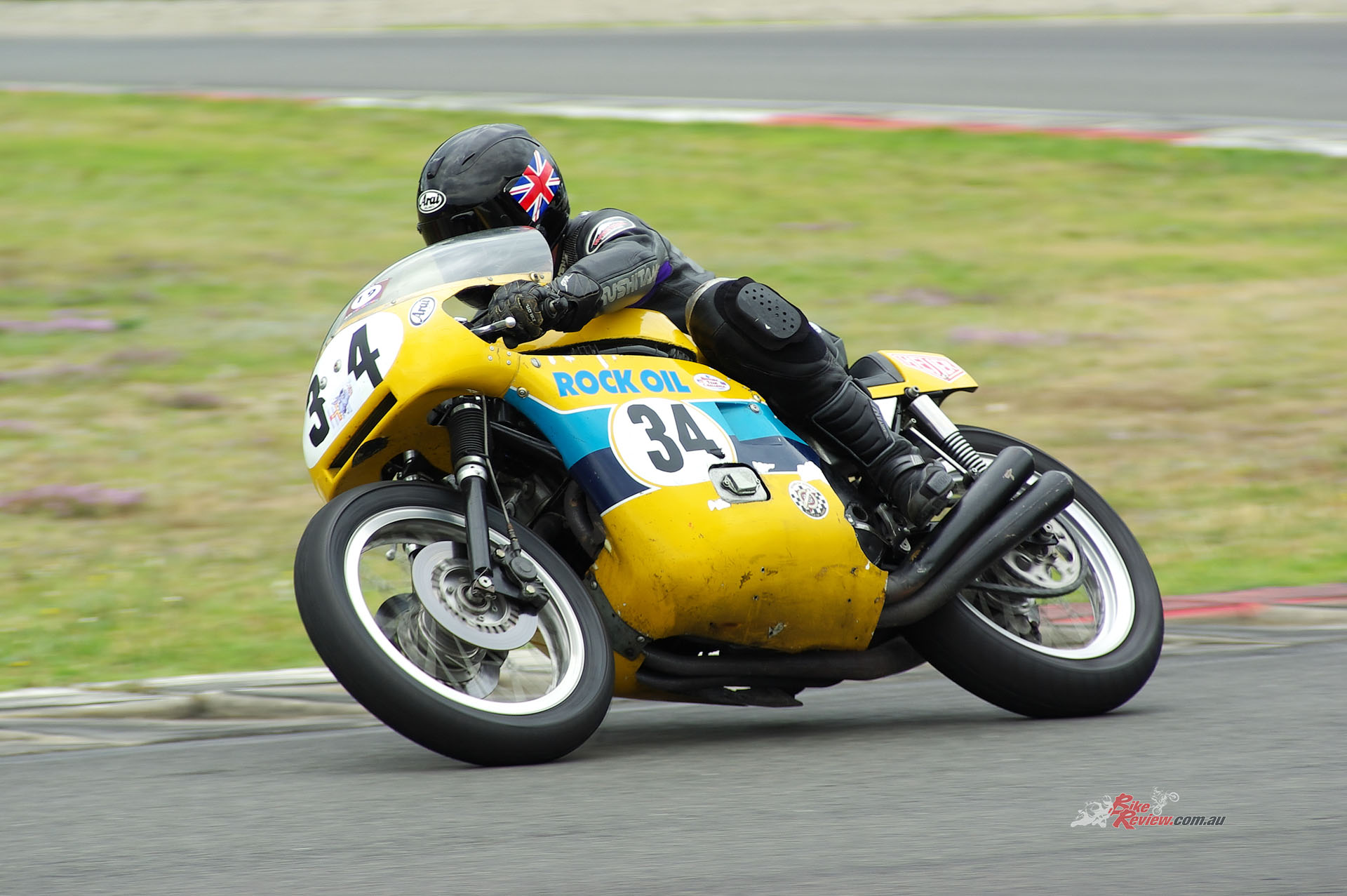
The Hadleigh Honda’s return to the racetrack under his ownership at the 2009 Varano Historic meeting in Italy, complete with the four unsilenced megaphone exhausts Paul Gaskin had fitted for his Daytona outing.
Chris did me the honour of asking me to undertake the Hadleigh Honda’s return to the racetrack under his ownership at the 2009 Varano Historic meeting in Italy, complete with the four unsilenced megaphone exhausts Paul Gaskin had fitted for his Daytona outing. This made it a huge crowd-pleaser, even if several observant fans kept asking why what they assumed was a Rob North Triumph-3 had four exhausts! Three months later Julian Soper was reunited with it at BSB Brands, where I spent part of one session riding round with him on the Boyer Triumph-3 which was indirectly responsible for its creation.
But owing to various pressures it took another decade for this much-loved motorcycle to make its return to the racetrack ridden by Gordon Russell in the 2019 Goodwood Members Meeting’s Formula 750 race, by which time it had been returned to the state in which Julian Soper last raced it, complete with 4-1 exhaust and TZ750 fairing.
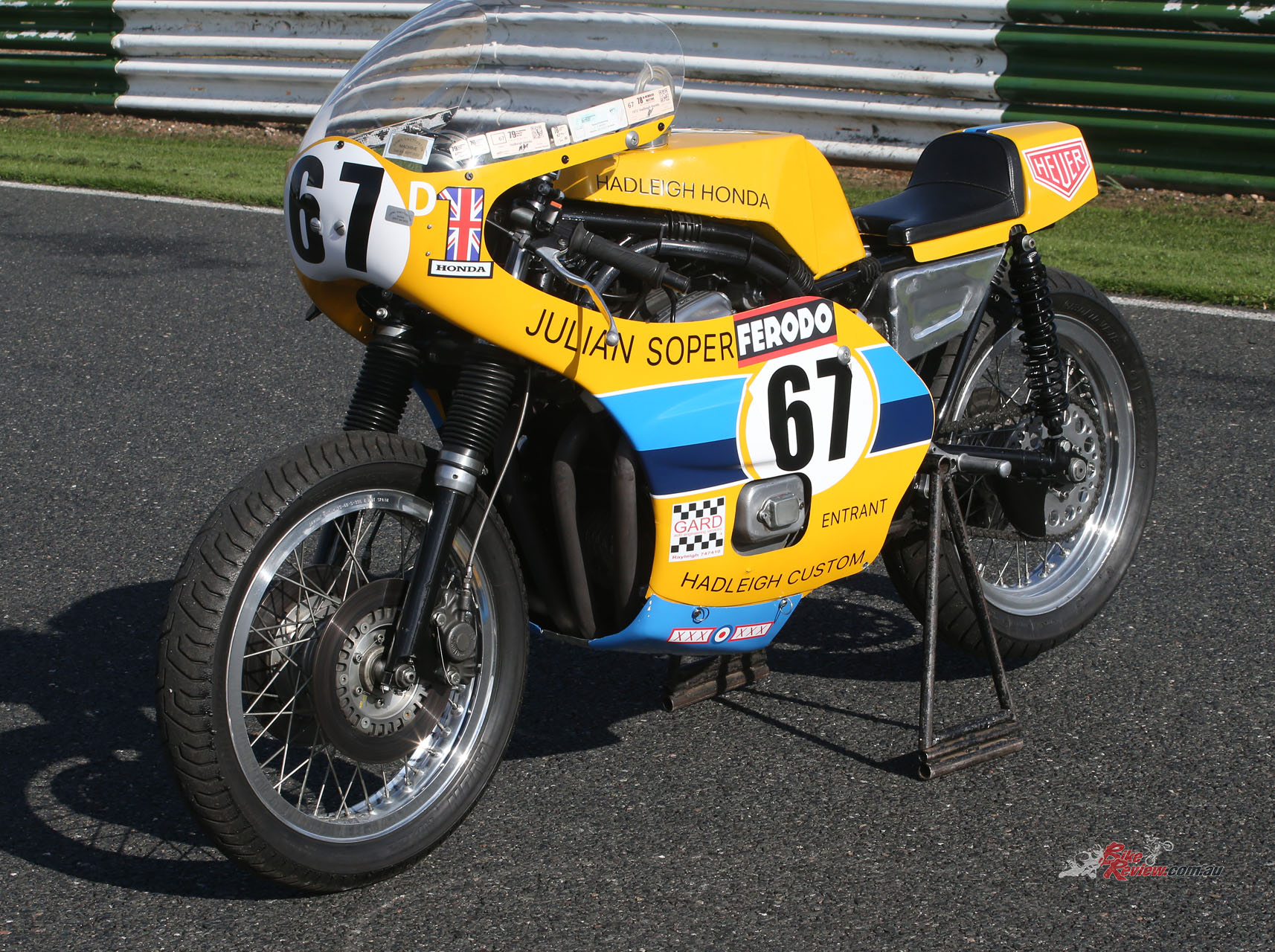
But owing to various pressures it took another decade for this motorcycle to make its return to the racetrack, by which time it had been returned to the state in which Julian Soper last raced it, complete with 4-1 exhaust and TZ750 fairing.
The engine however is still the 750cc motor installed when Soper sold it, which was evidently kitted out with heaps of factory parts by Bill Smith, using his close connections with the Honda factory race department – he was supposed to ride the 1969 Bol d’Or winner until licencing issues intervened, and was part of the four-man Honda factory team for the 1970 Daytona 200.
That surely explains the unobtainium RSC self-generating ignition system which Gordon Russell discovered when he rebuilt the engine, as well as the close-ratio RSC gearbox. Somewhat inevitably given the many racing miles the motor has undergone since leaving Bill Smith’s hands, its internals are now mostly stock, including the unlightened crank with polished conrods, but with what Russell describes as “a very nicely ported cylinder head” plus a racing camchain with modified tensioner and twin single-row primary chains, and a heavy duty drive chain.
Fitted with four 33mm Keihin CR carbs Gordon estimates power to be around 75hp@9,500rpm, taking the known quantity of the tricked-out 85bhp 750cc Triumph triples he’s raced it against en route to three top ten F750 finishes at successive Goodwood Members Meetings. “It’s a little bit slower than them, but fast enough to keep up,” he says. “Chris and I were determined to get it raceworthy again, but we’ve never planned on making it into a contender for victory, because it’s not the right thing to do with what amounts to history on wheels.”
I’m well qualified to attest to that, having shared the track on several occasions in 1975-76 with Julian Soper aboard this bike – him at the sharp end of the field, me at the back on my Ducati 750SS doing double duty as a pretty competitive Production racer and a making-up-the-numbers Unlimited class bike, which helped me get crucial extra track mileage in the early days of my racing career.
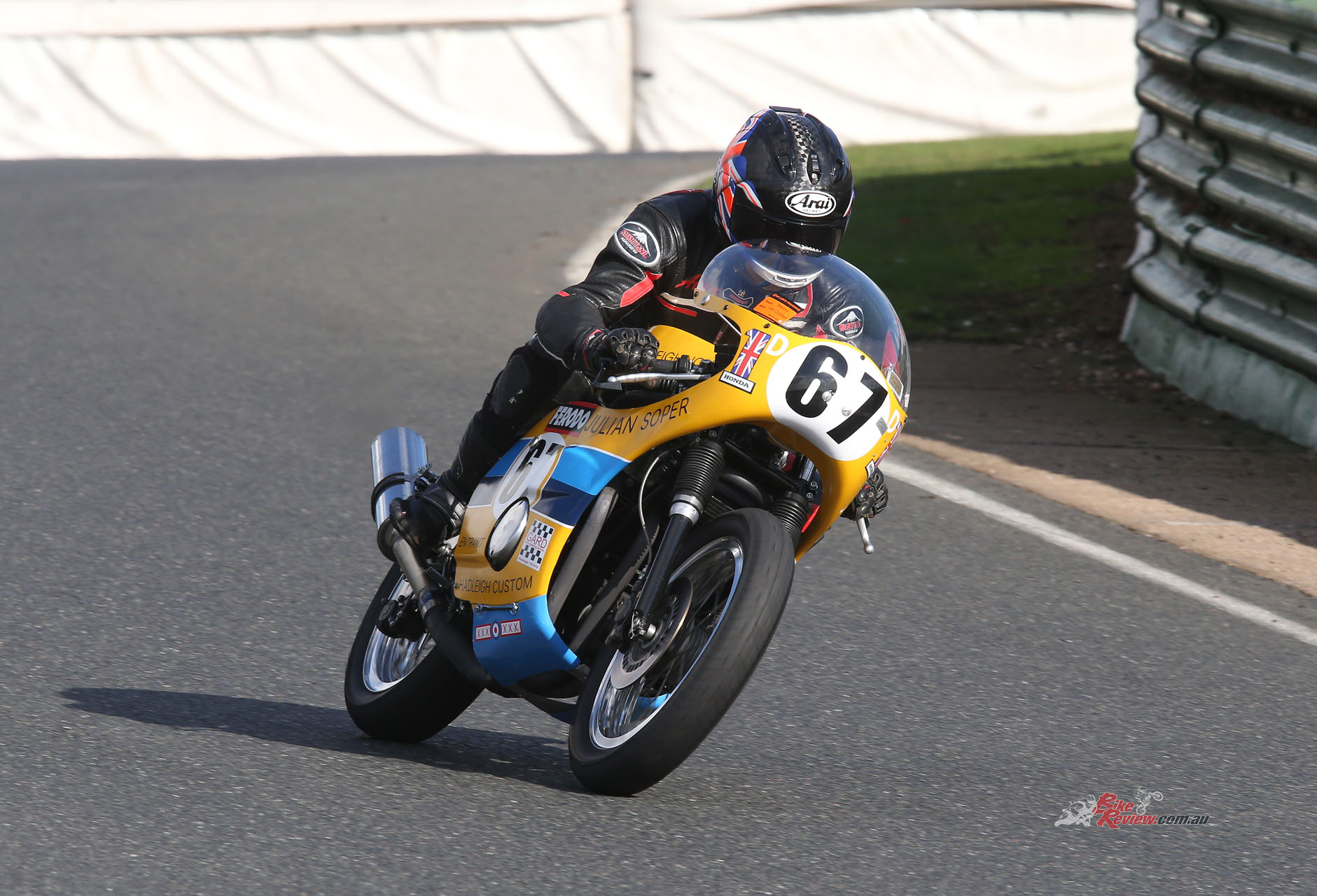
Alan had a chance to ride the Hadleigh Honda on multiple occasions. Finally riding it in its correct fairing.
I’d expected riding it for the first time at Varano to be another trip down memory lane, after three seasons of racing my genuine Rob North-framed BSA-3 at the highest level of TT F1, including the Isle of Man TT, Silverstone, Vila Real etc. I was expecting the Hadleigh Honda to have the same cramped riding position with high-set footrests and precious little space to move around the bike, coupled with a screen that was hard to tuck away behind – so it was quite a surprise to find a more, er, rational riding stance on the Honda-engined version of that frame.
But this was three months before I met Julian Soper for the first time, and realised how tall he was – so all I can say is he did a good job of making the bike rideable for someone of his stature, or a little less. And while the screen of the letterbox fairing fitted to the bike when I rode it at Varano was just as awkward as my BSA-3’s to tuck behind, the TZ750 aftermarket fairing fitted to the bike when I rode it a second time at Mallory Park last October completely took care of that – I could tuck right away down Mallory’s Pit Straight.
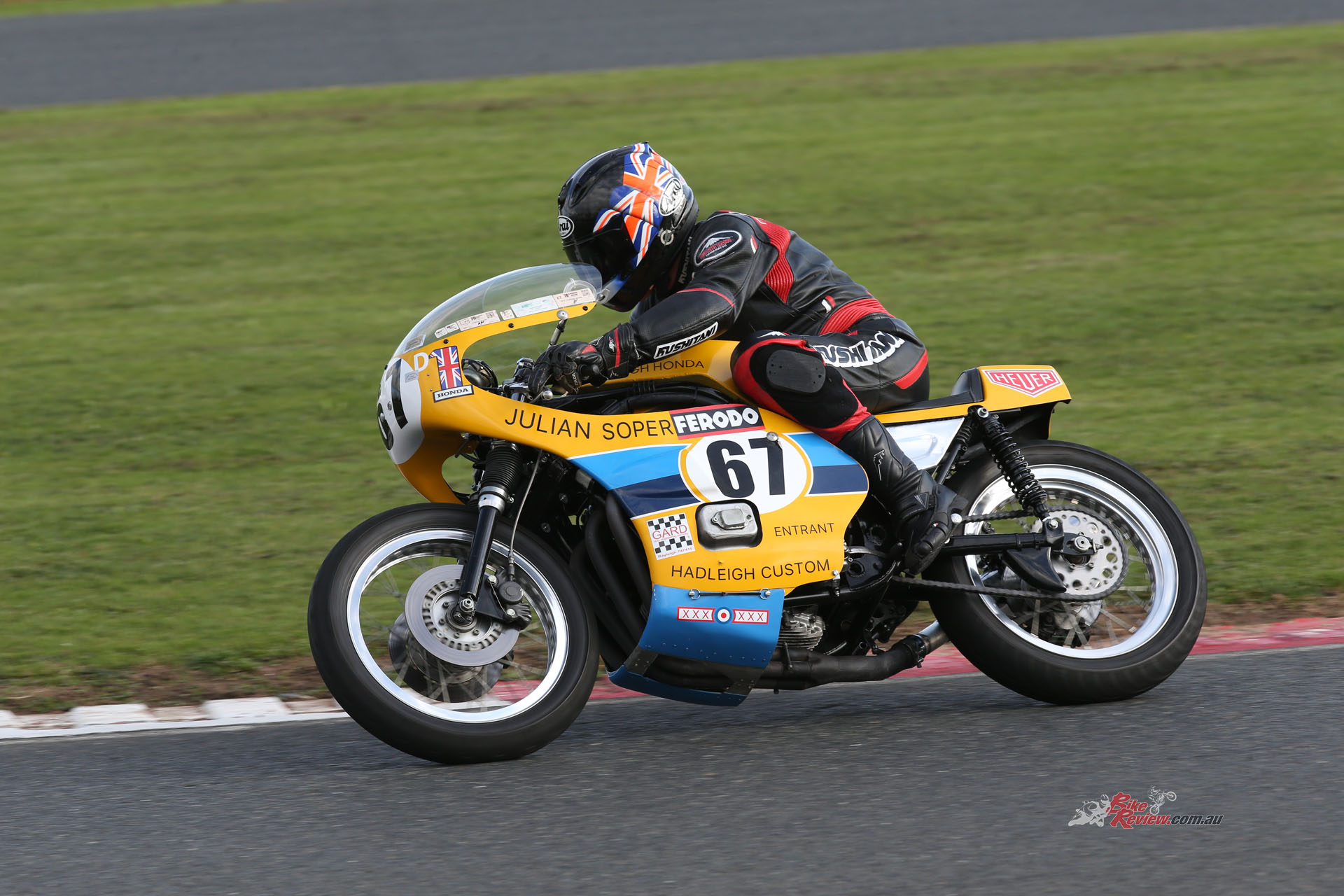
For our Mallory Park outing Gordon Russell had had to fit a silencer to the 4-1 open exhaust Soper always raced the bike with in 900cc form.
For our Mallory Park outing Gordon Russell had had to fit a silencer to the 4-1 open exhaust Soper always raced the bike with in 900cc form (and which is maintained for its Goodwood appearances thanks to the Duke of Richmond’s ban on silencers!), so it wasn’t fair to criticise the pretty hefty flat spot between 4,500-5,500 rpm I had to cope with if I ever let the revs drop that low exiting either chicane, or the Hairpin. I do remember there was the same hiccup with the unsilenced megaphones at Varano, but you’d expect that with those.
The solution is obviously to keep the revs up wherever possible, and in Italy I’d done that to general approval from assorted concert-goers, while maintaining the same 9,800 rpm shift point I did at Mallory – the engine is probably safe to 10,800 revs, but why risk it? But at Mallory it was difficult to do that because of gear selection problems – the one-up race-pattern left-foot shifter without any linkage is crisp and direct, but half a dozen times it refused to shift at all, and sometimes jumped out of third gear even after I’d been super-careful about feeling it home.
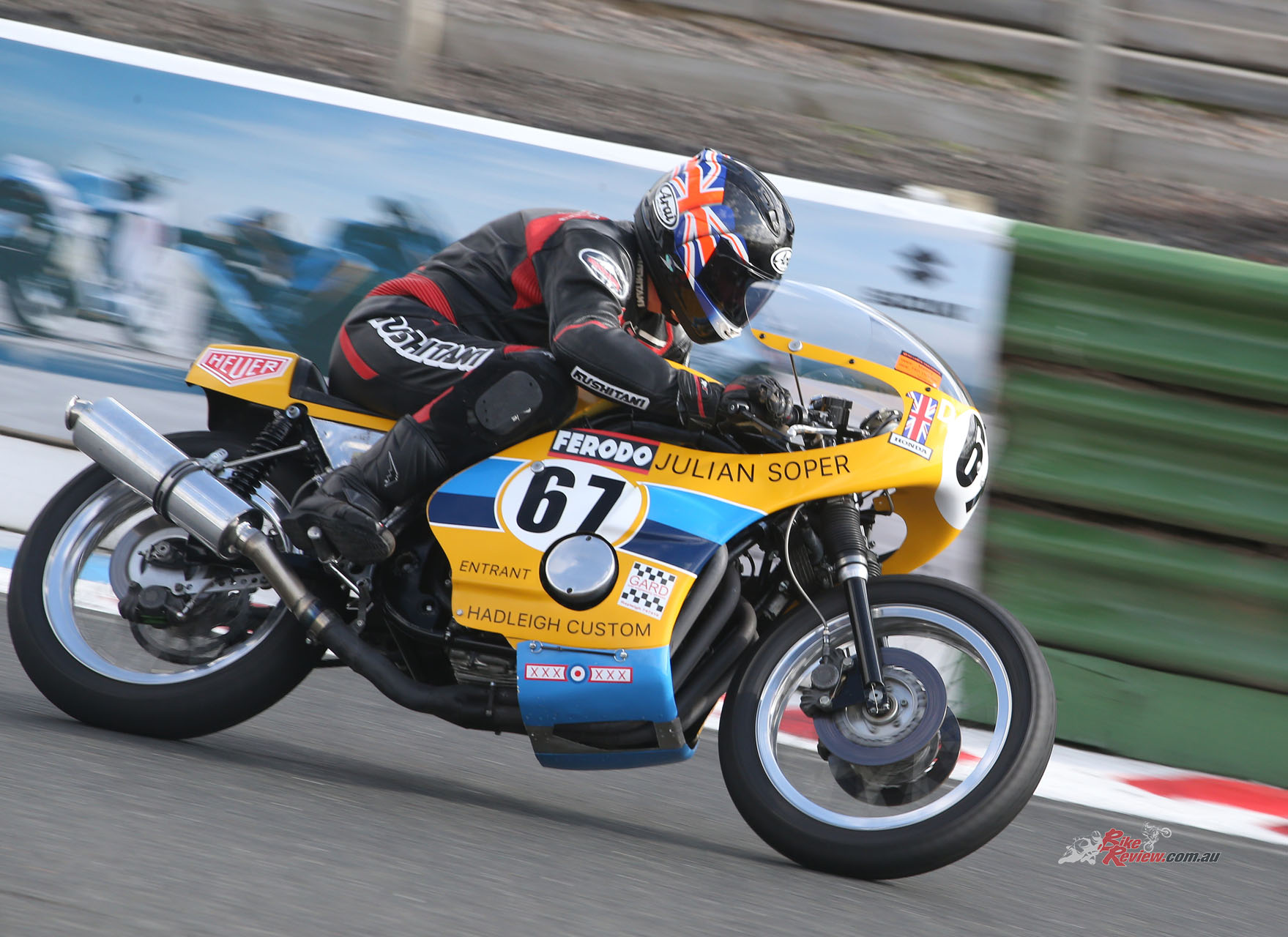
“The one-up race-pattern left-foot shifter without any linkage is crisp and direct, but half a dozen times it refused to shift at all and sometimes jumped out of third gear even after I’d been super-careful about feeling it home.”
A winter stripdown to provide Mike Rutter with a proper transmission for Goodwood will have been in order – but I’m sure he’ll appreciate the way the engine picks up revs pretty quickly despite the standard crank, helped by the crisp response of the CR Keihin carbs. On its Goodwood gearing I could only get fourth gear at Mallory, but it felt pretty quick down the Pit Straight.
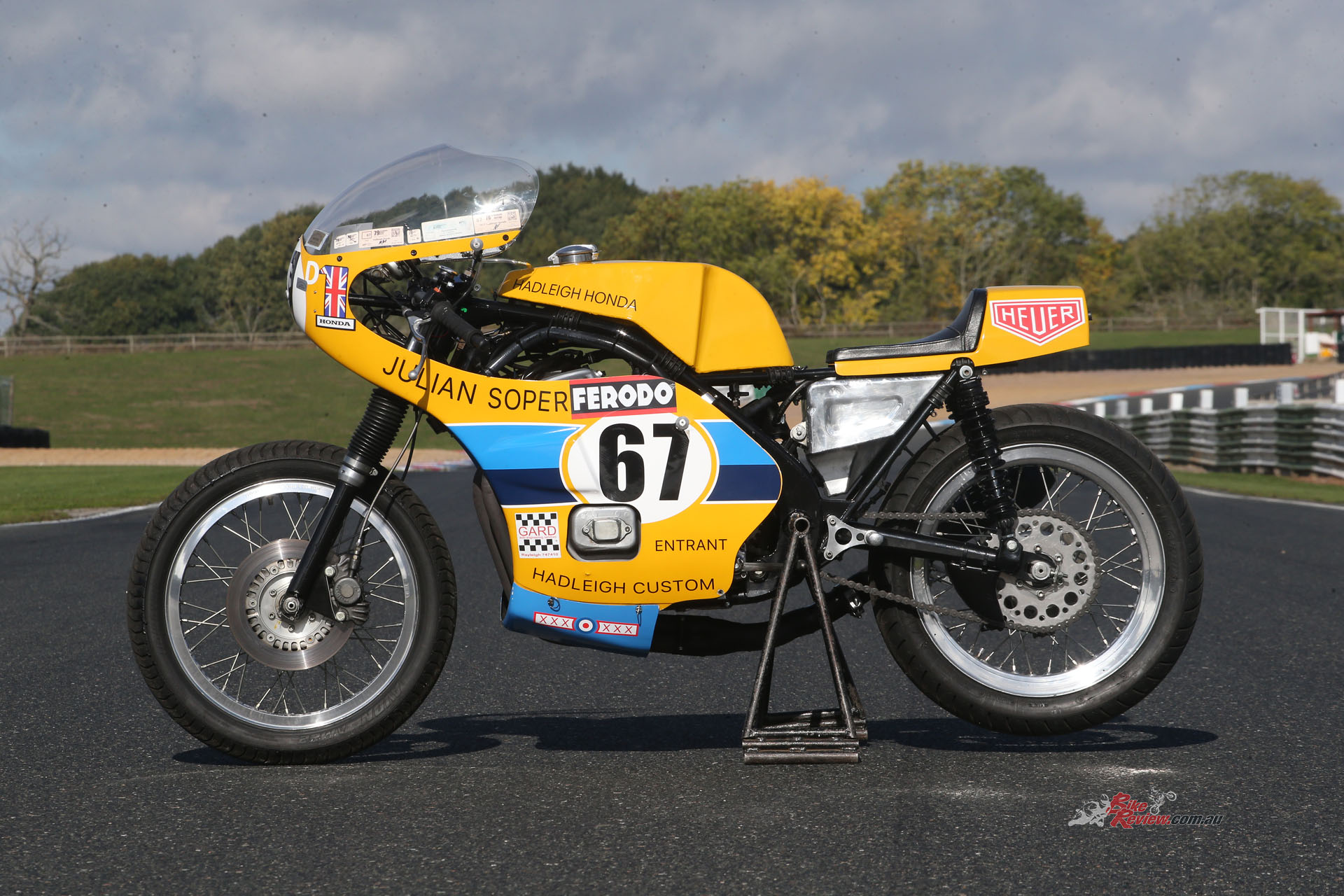
No denying this is an epic looking machine. Everything from the TZ fairing to the yellow and blue combo just works!
When I first rode the Honda at Varano I was quite disconcerted by the pretty massive front wheel chatter, worst of all on the one fast corner there on a chicane-littered track coming on to the Pit Straight, where you’re accelerating hard leant right over, so with less weight on the front wheel. There was no trace of that at Mallory, so job done – while he focused on the engine Gordon had entrusted the job of rebuilding the chassis to his Kent-based mate Nigel Banks, we’ll let him tell us how he fixed that.
“We took the frame down to Motoliner in Maidstone, and found it was 15mm out of line at the back,” says Nigel. “So we had that straightened, replaced one frame tube, then rebuilt the forks and fitted new bearings everywhere, including the needle roller swingarm bearings and tapered needle roller steering head fitments. Where we’ve come to now is the end process of making it into a nice bike to actually race – but it took a while to sort out the handling. We originally fitted 12mm long Koni shocks, then 13mm Hagons which lifted the rear and made it steer nicer in turns, without any stability problems in a straight line. But some damping problems remained, so now we have fully adjustable K-Tech shocks on it sourced from Stuart Tonge. He identified the fork as a very early Maxton conversion to the Triumph T160 front end used on all Rob North frames, and basically he just refurbished and re-bushed everything. Gordon says it handles quite nicely, now – do you agree?”
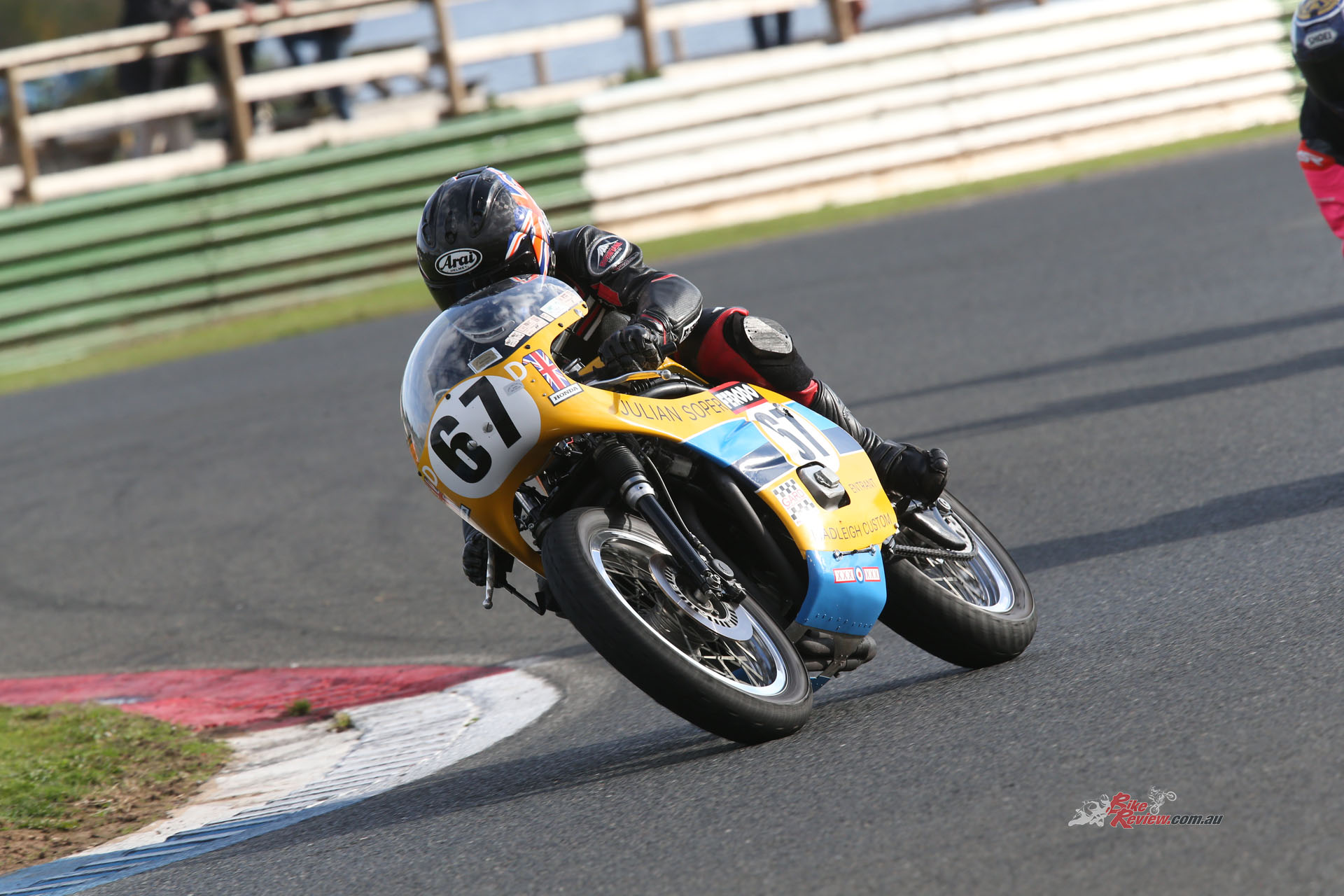
“In both chicanes the Hadleigh Honda flicked almost effortlessly from side to side, shrugging off the effects of the ripple strips on the front damping if I tried to cut things t super-fine for a faster entry.”
Well, yes – after 30 laps of Mallory Park I certainly do, because holding third gear hard on round Gerards had the bike tracking perfectly in best Goodwood mode, where holding a line in fast sweepers like this is all-important. But in both chicanes the Hadleigh Honda flicked almost effortlessly from side to side, shrugging off the effects of the ripple strips on the front damping if I tried to cut things t super-fine for a faster entry.
The twin cast iron front discs with their peerless-for-the-period Lockheed calipers did a good job in stopping hard for the Hairpin, and I was able to help them with some engine braking from the 10.2:1 compression motor without ever getting the rear wheel chattering and having to fan the pretty stiff-action clutch. What a nice ride – do you mean I could have got my Rob North BSA-3 handling as well as this if I’d kept it another 35 years?
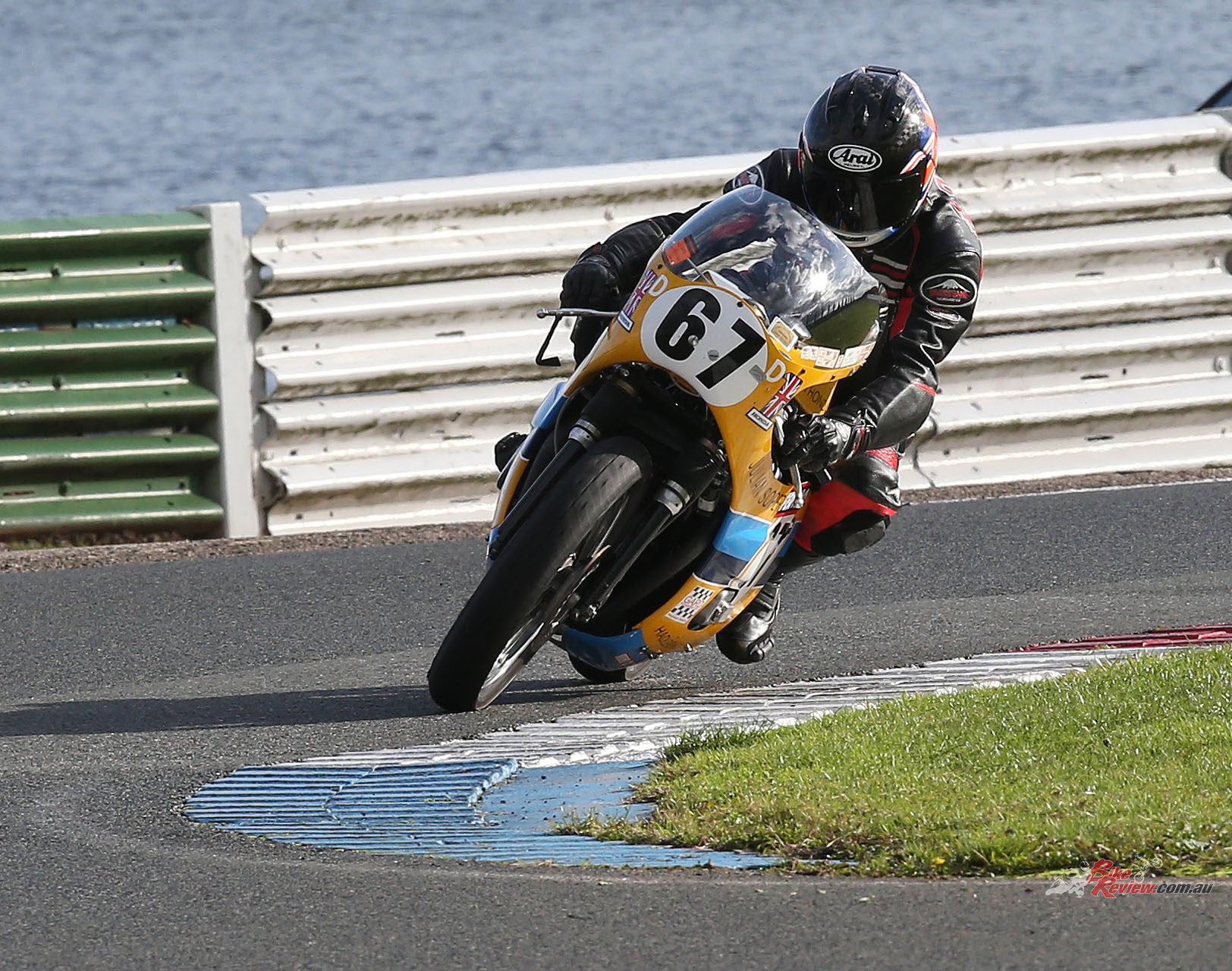
“The twin cast iron front discs with their peerless-for-the-period Lockheed calipers did a good job in stopping hard for the Hairpin, and I was able to help them with some engine braking from the 10.2:1 compression motor.”
Let’s leave it to Chris Wilson to put the significance of the Hadleigh Honda into perspective. “Despite the array of factory Grand Prix 500s I’m fortunate to own, this is without any shadow of a doubt my favourite bike in the collection,” he says. “It’s a complete memory-jerker – just today at an end-of-season track day four different people have come up and said, “Oh, I remember that bike!” No motorcycle I’ve ever owned has had as much attention as this one, basically I think because Julian Soper was seen as the perpetual underdog we British love to support competing on a glorious-sounding motorcycle against all the factory bikes and dealer-supported teams. I know it’s the one bike my wife would never let me sell – but I don’t think I’d ever want to!”
1973 Hadleigh Honda 750 Specifications
ENGINE: Air-cooled SOHC transverse in-line four-cylinder four-stroke with central chain camdrive, 736cc, 10.2:1 Compression Ratio, 4 x 33mm Keihin CR, RSC self-generating energy transfer, 61 x 63mm bore x stroke, 5-speed RSC close-ratio with 2 x single-row chain primary drive, Multiplate oil-bath clutch.
CHASSIS: TRob North bronze-welded duplex frame in Accles & Pollock T45 steel tubing, Front: Modified 33.3mm Triumph T160 telescopic fork with Maxton internals, Rear: Tubular steel swingarm with 2 x fully adjustable K-Tech shocks, Front: 110/80-18 Avon AM22 on WM3/2.15in Borrani wire-laced aluminium rim Rear: 130/70-18 Avon AM23 on WM4/2.50in Borrani wire-laced aluminium rim, Front: 2 x 203mm Triumph cast iron discs with two-piston Lockheed calipers Rear: Triumph 1 x 178mm cast iron disc with two-piston Lockheed caliper
PERFORMANCE: 75hp@9,500rpm (estimated, at gearbox), 175kg dry, 233km/h top speed
OWNER: Chris Wilson, Manston, Kent, Great Britain
1973 Hadleigh Honda 750 Gallery
Editor’s Note: If you are reading this article on any website other than BikeReview.com.au, please report it to BikeReview via our contact page, as it has been stolen or re-published without authority.

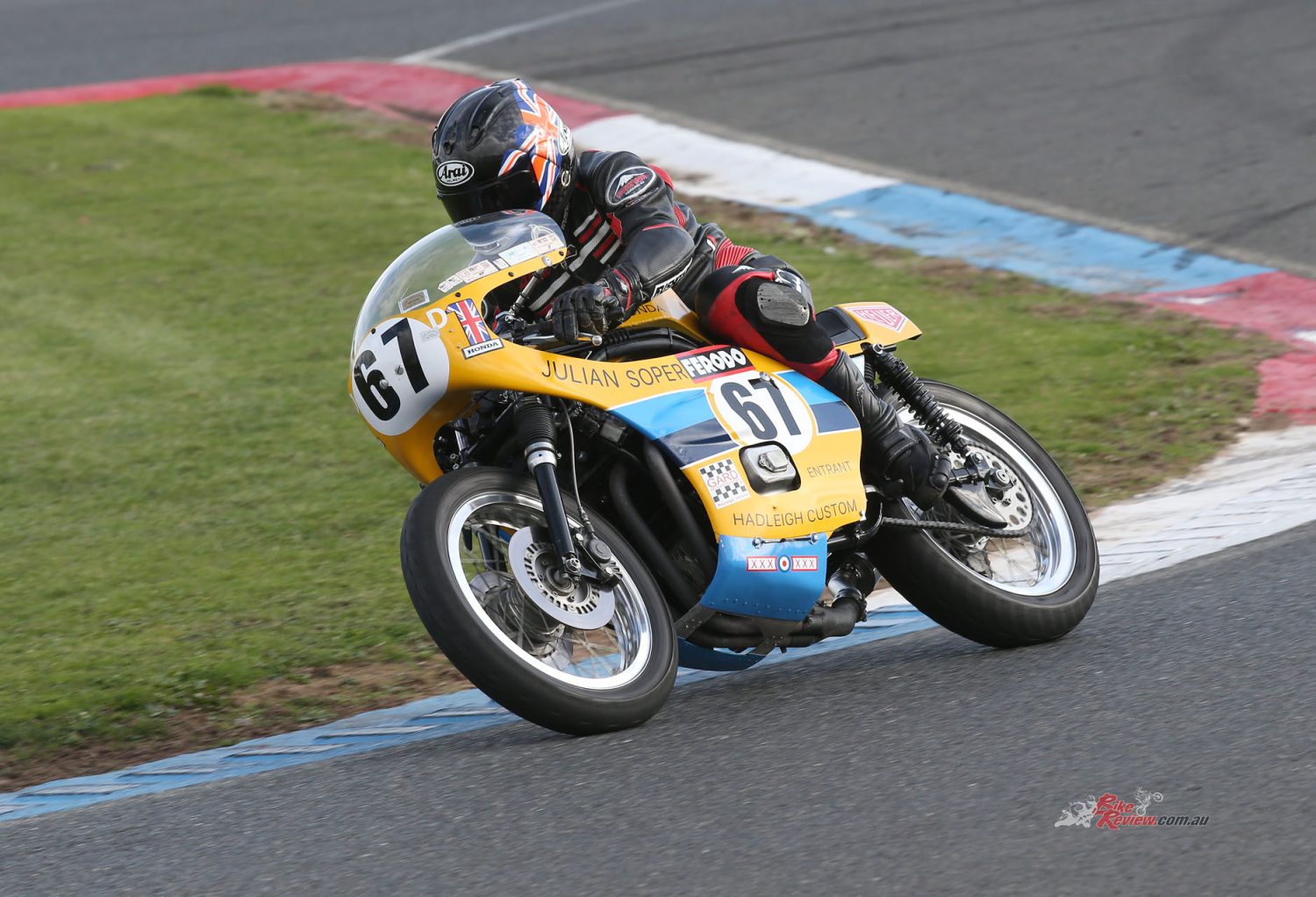
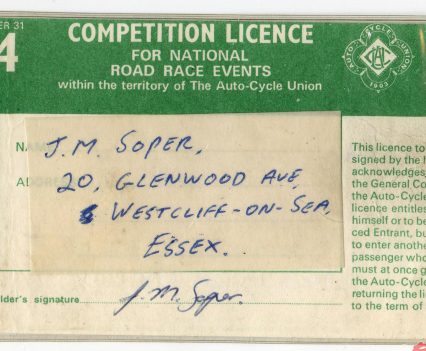
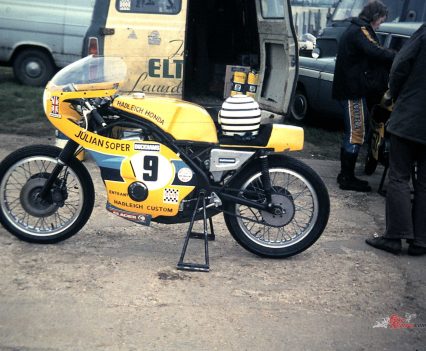
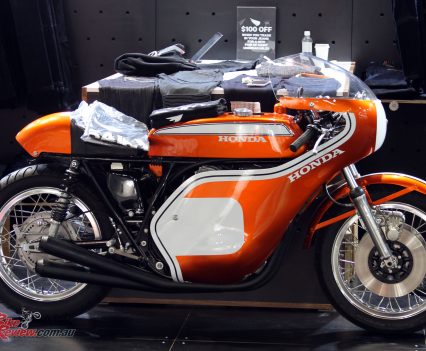
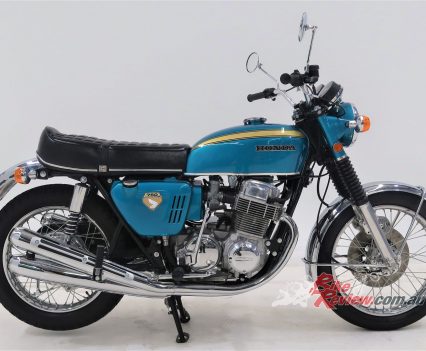
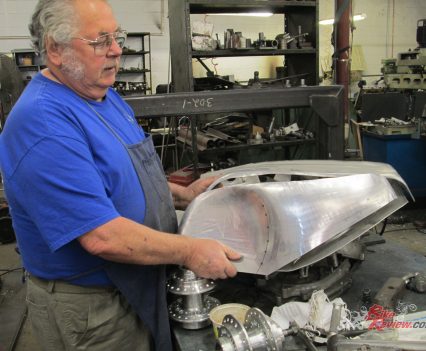
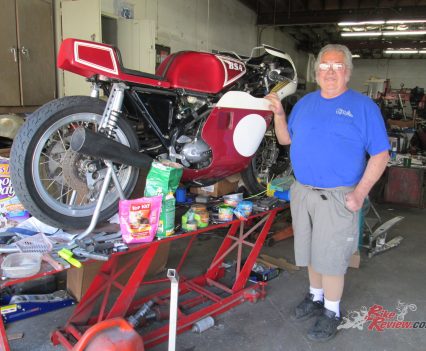
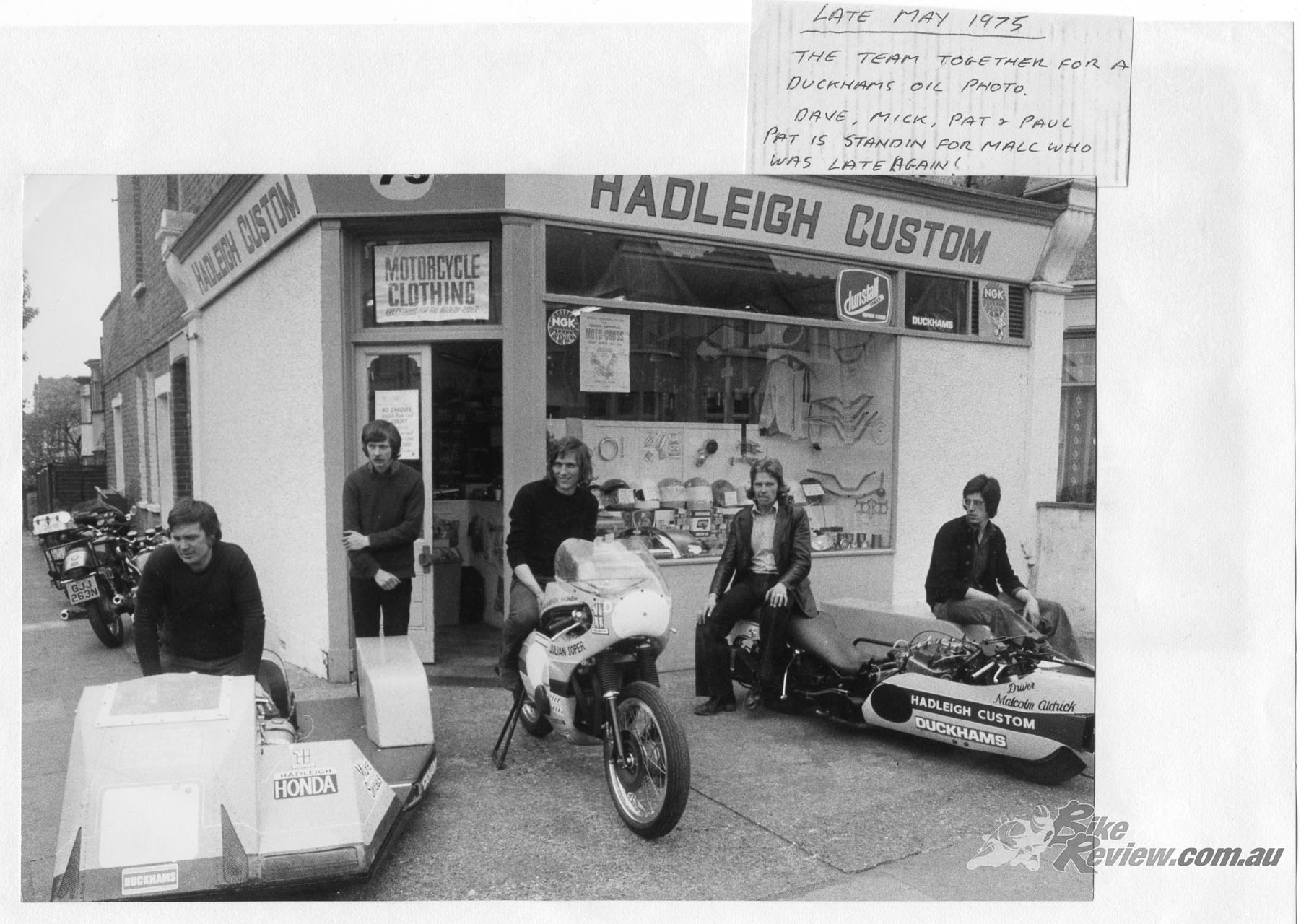
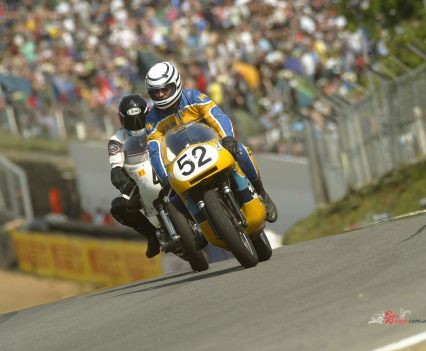
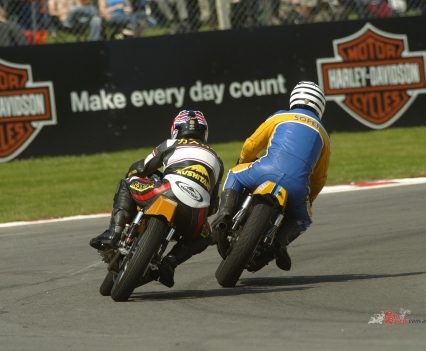
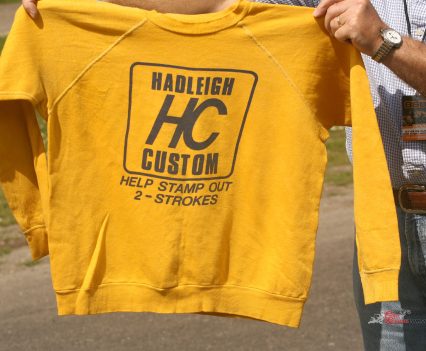
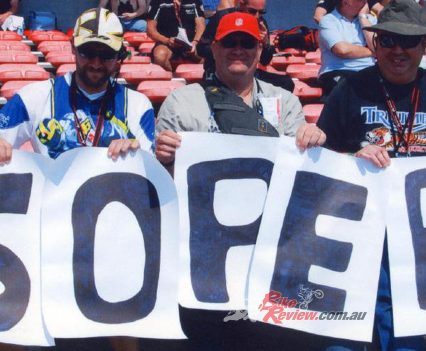
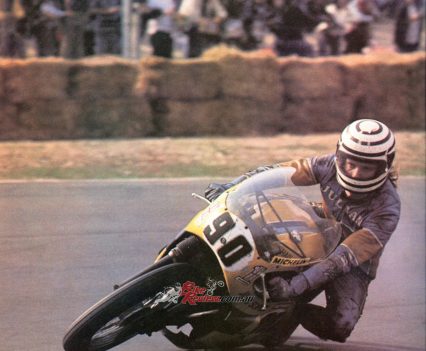
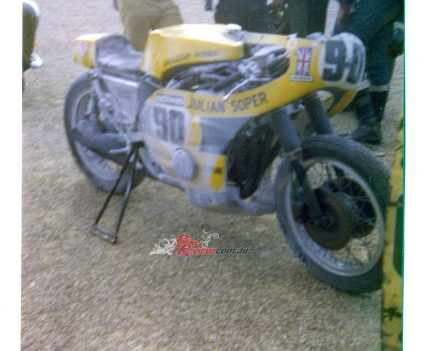
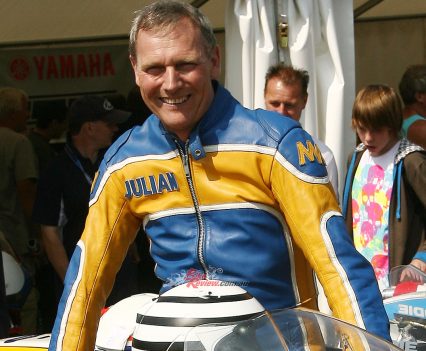
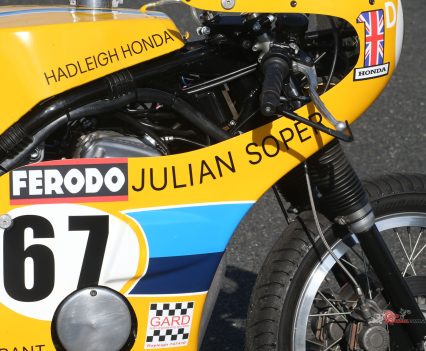
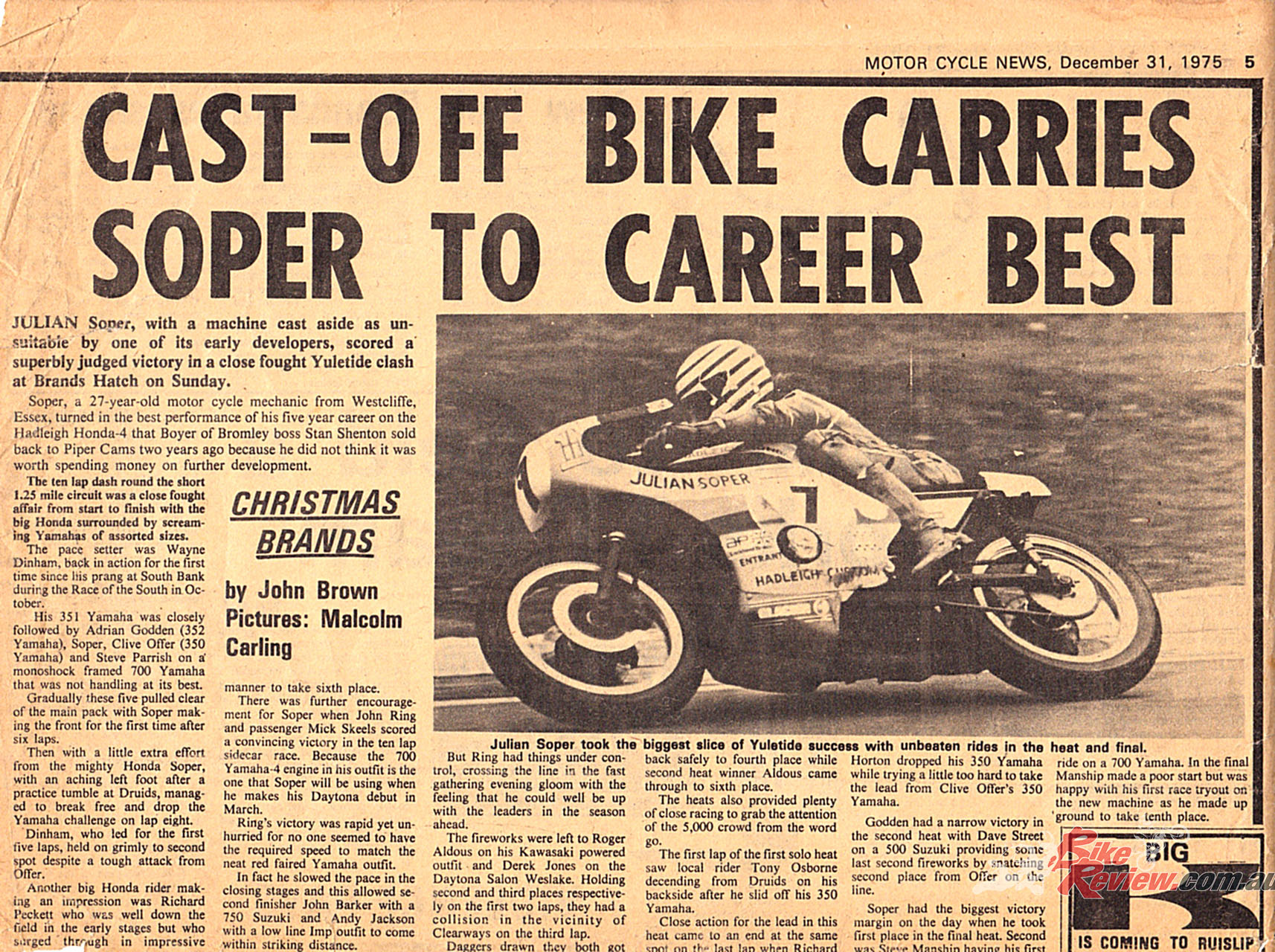
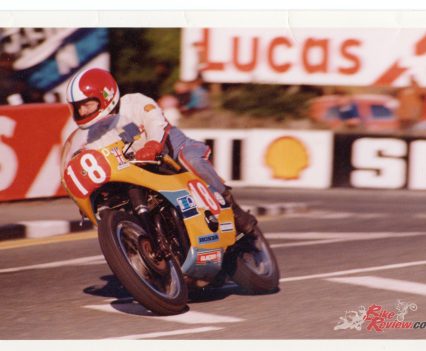
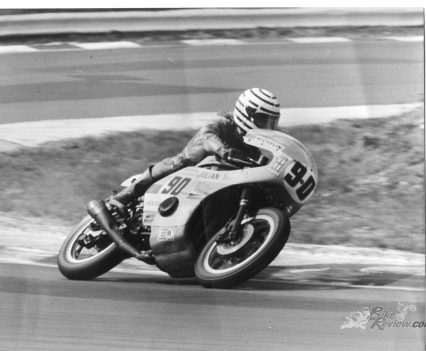
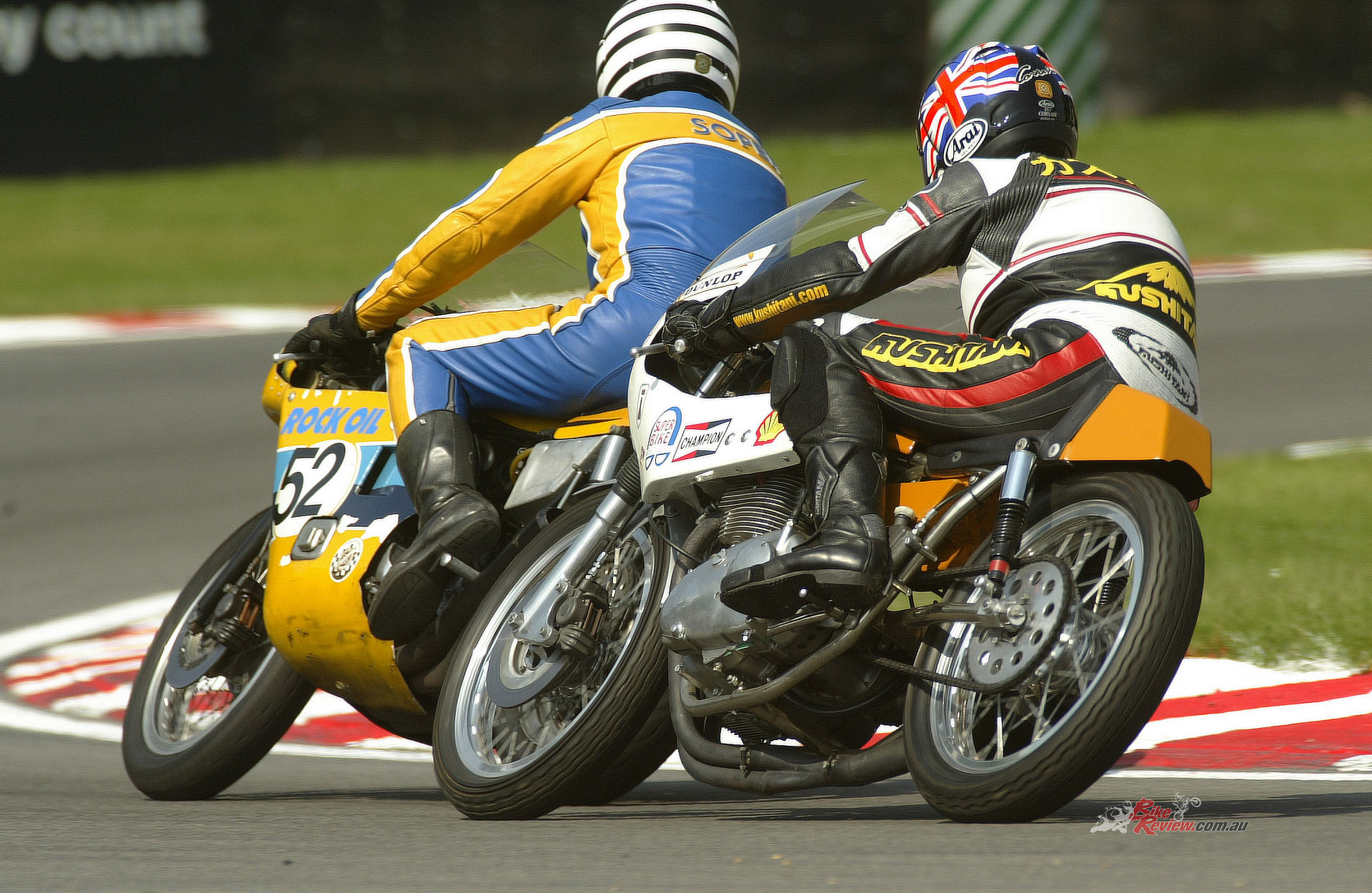
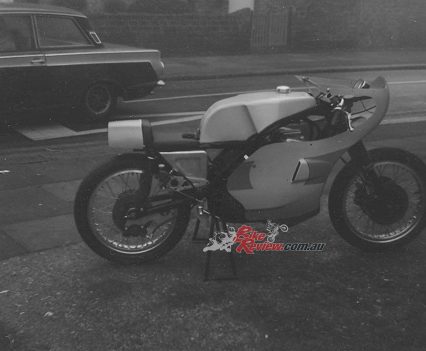
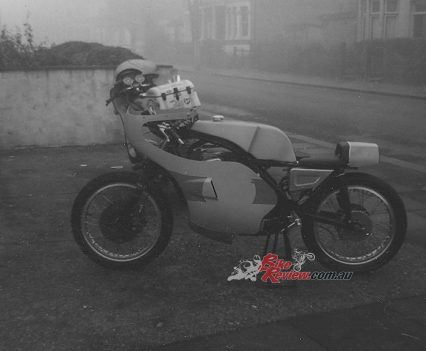
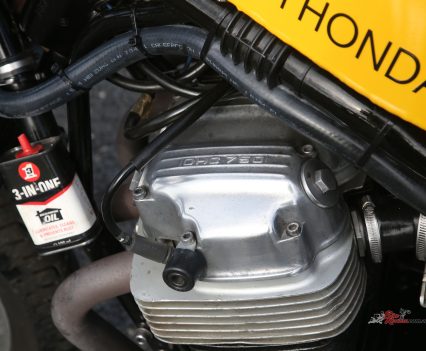
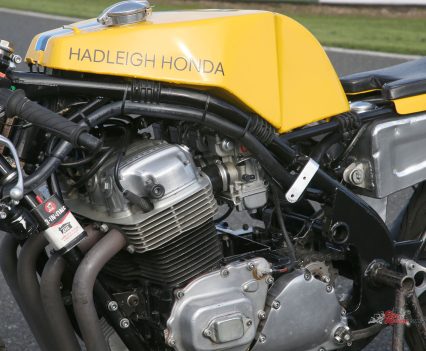
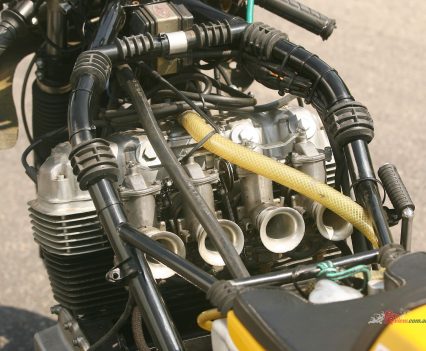
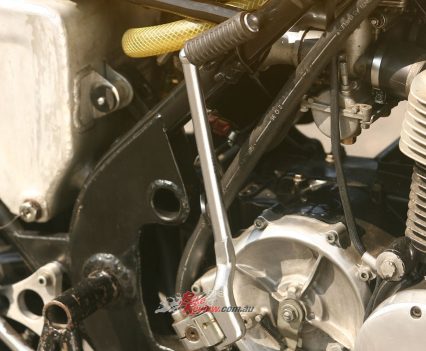
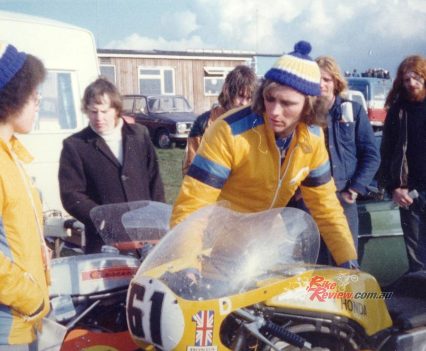
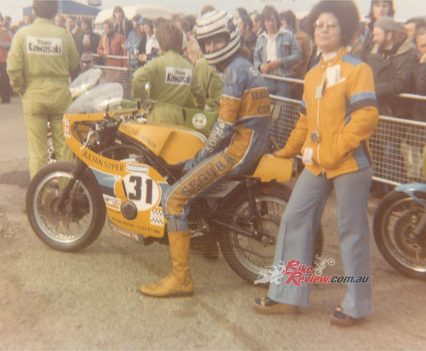
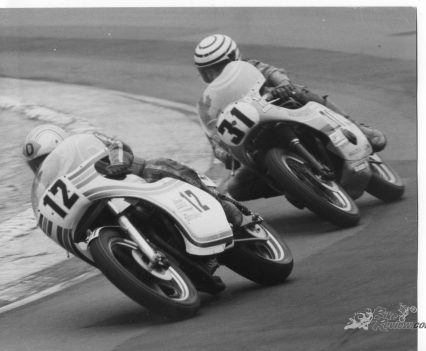
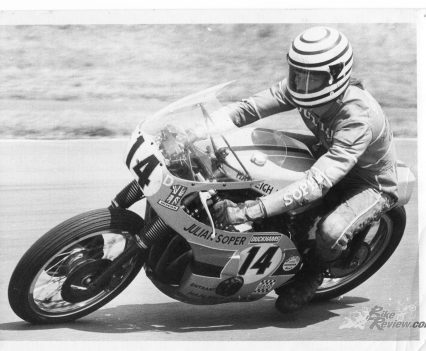
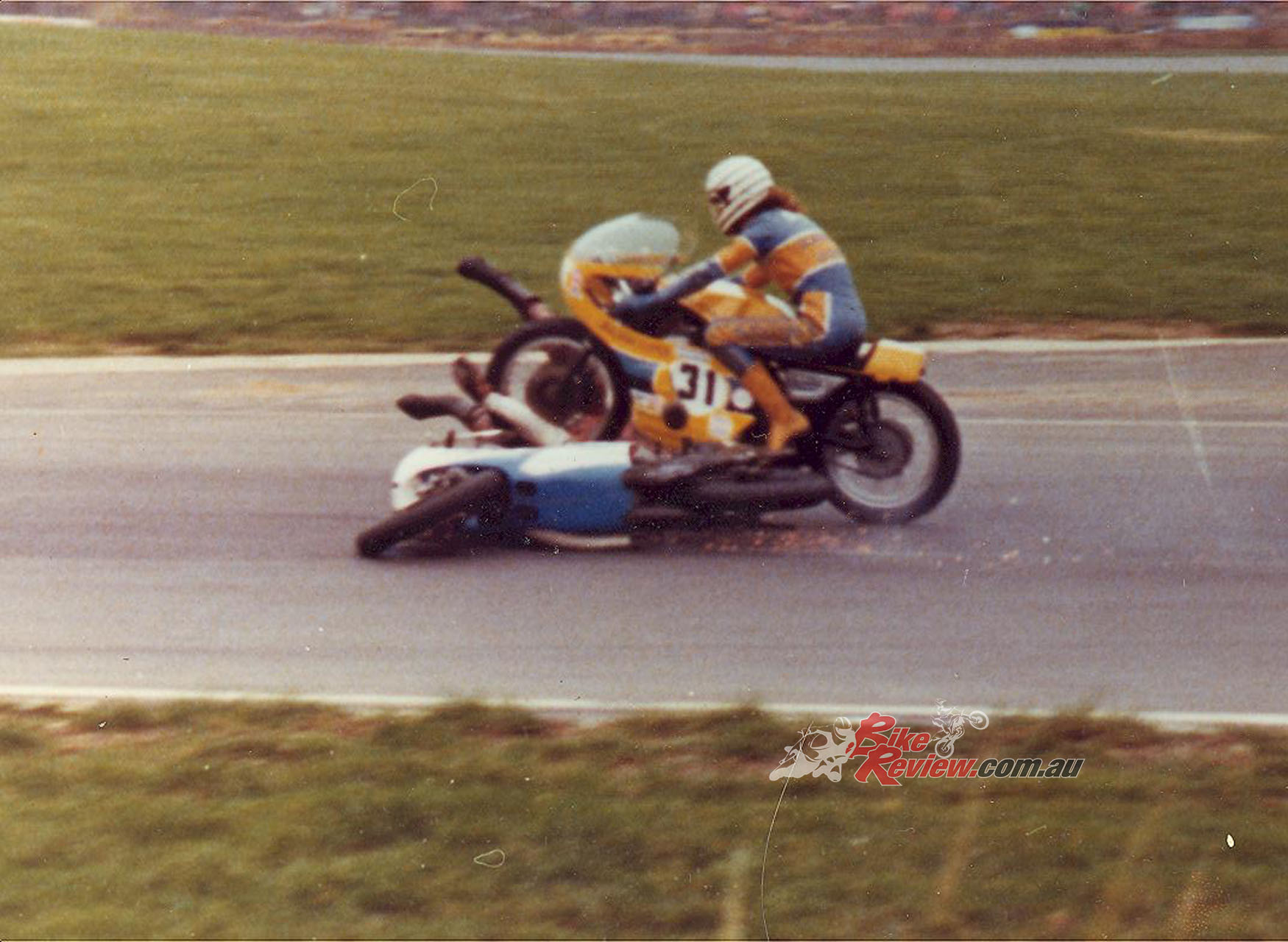
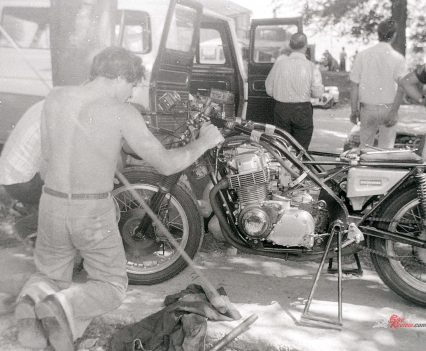
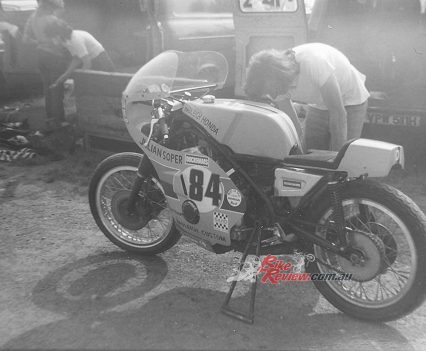
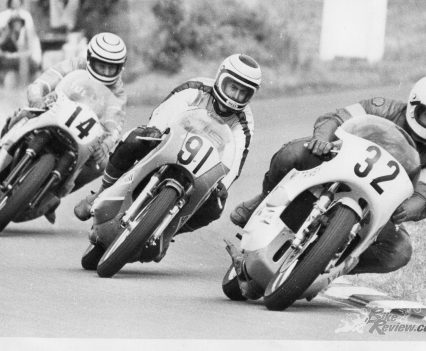
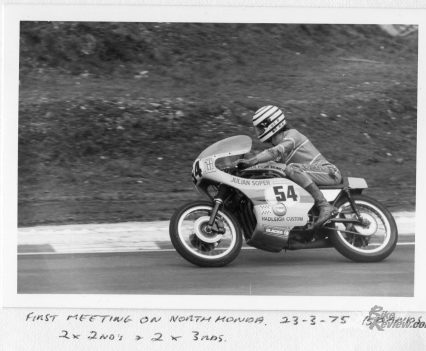
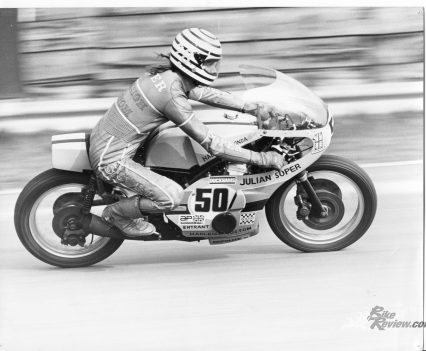
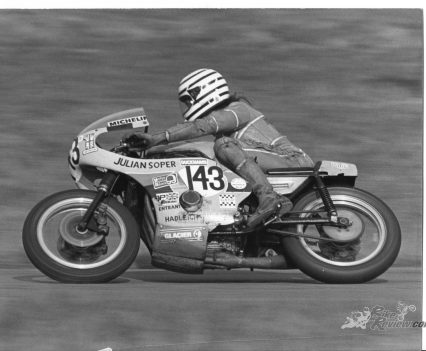
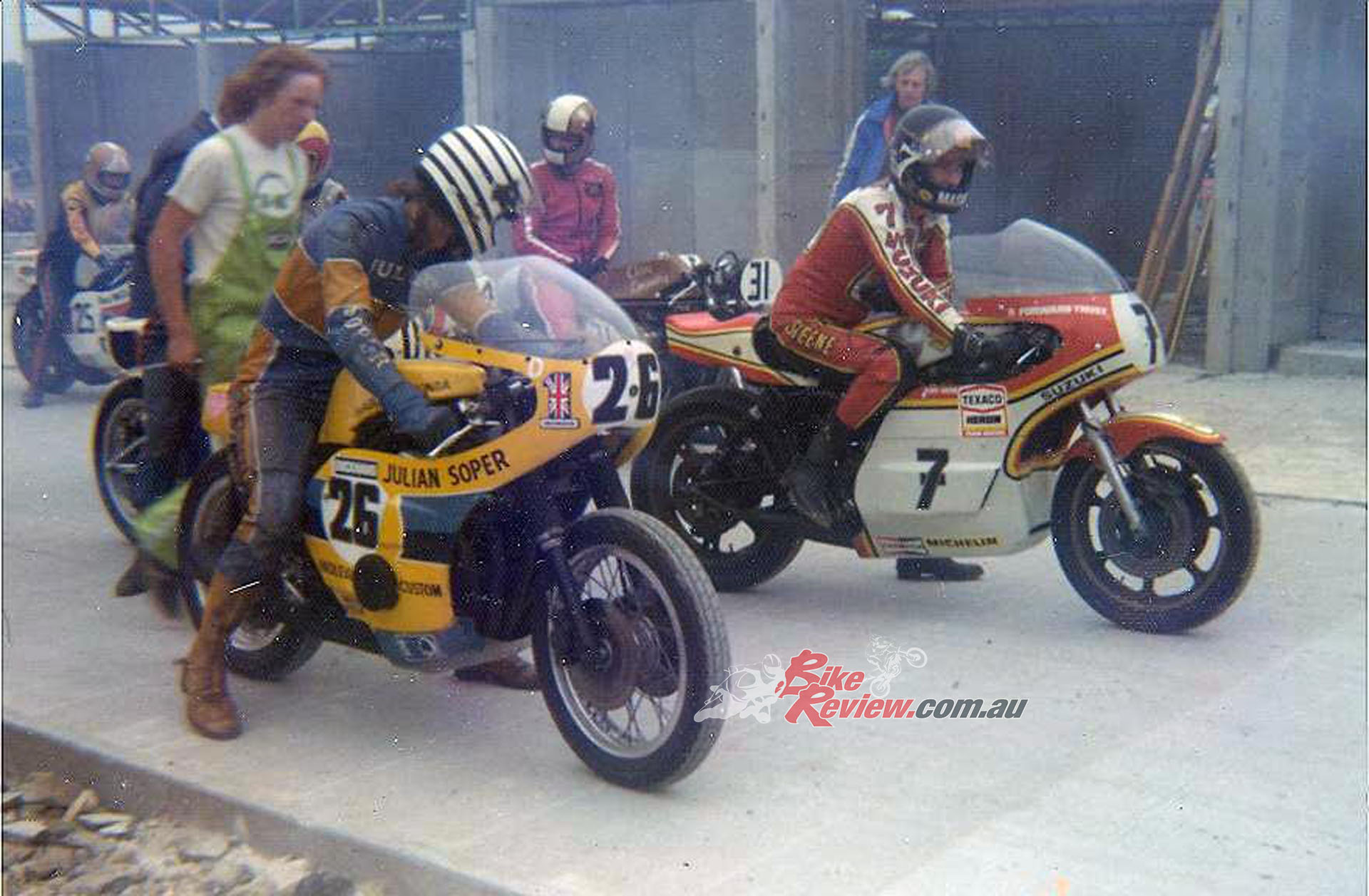
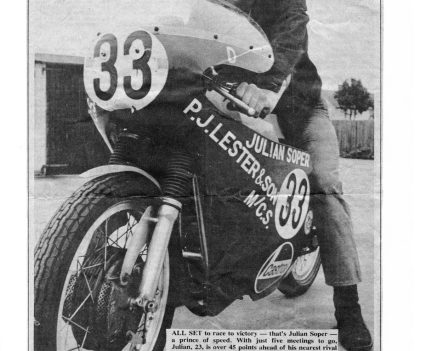
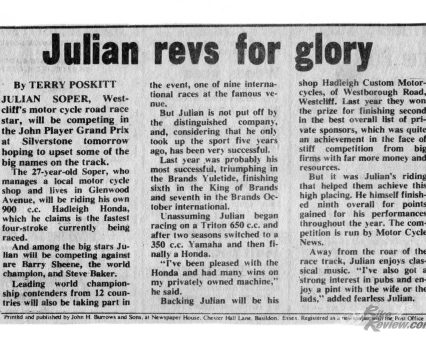
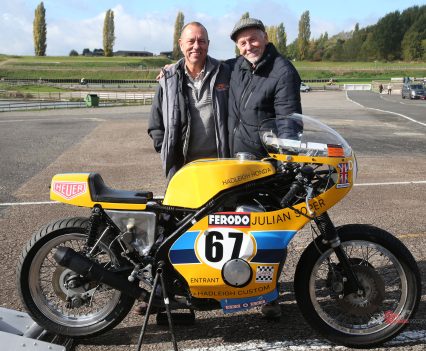
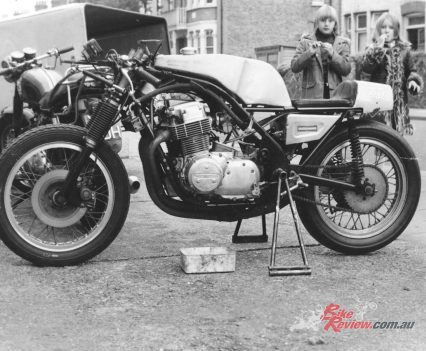
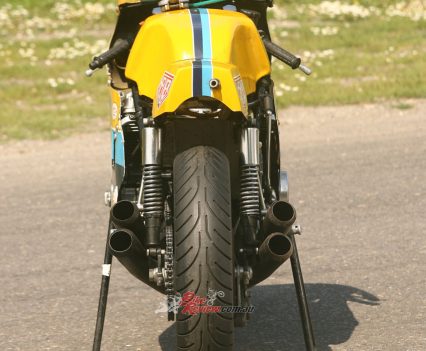
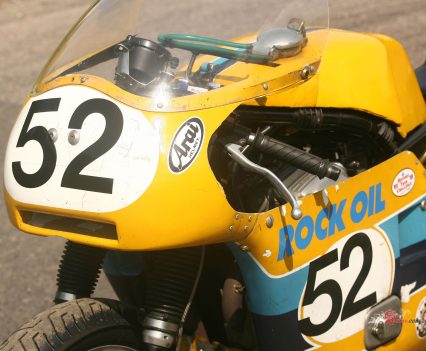
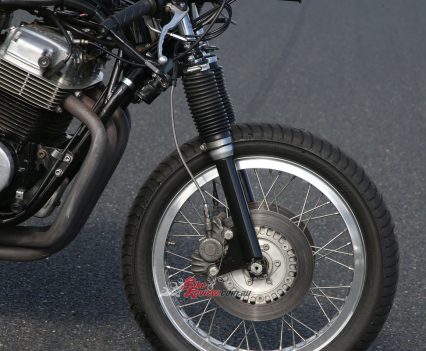
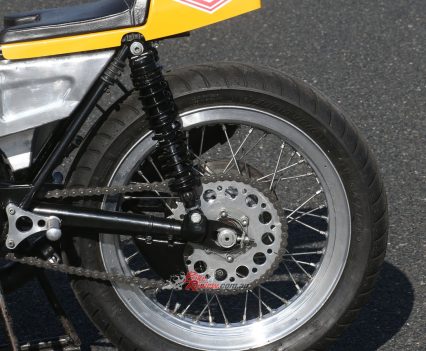
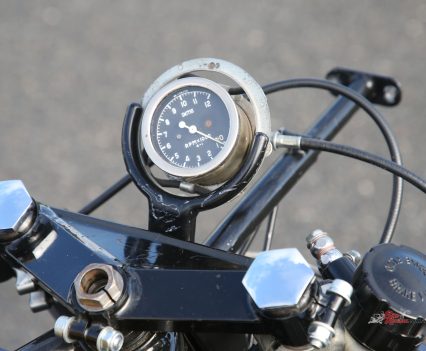
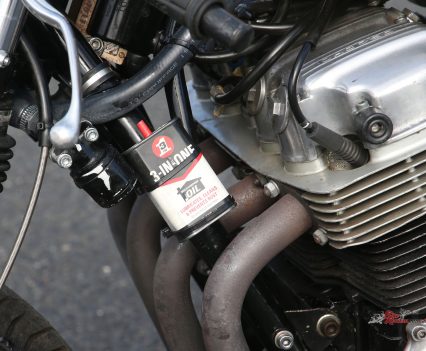
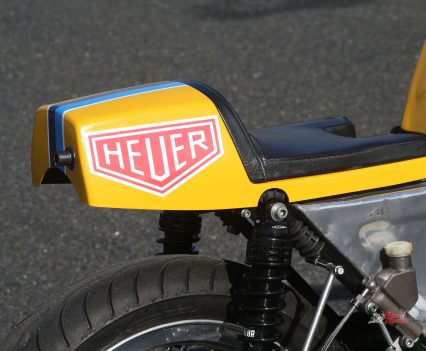
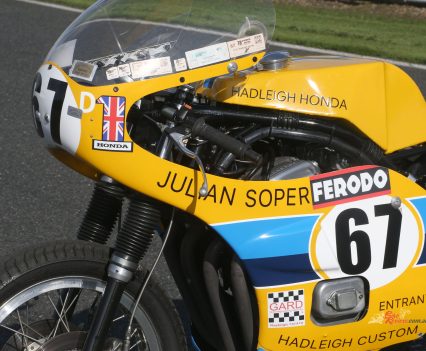
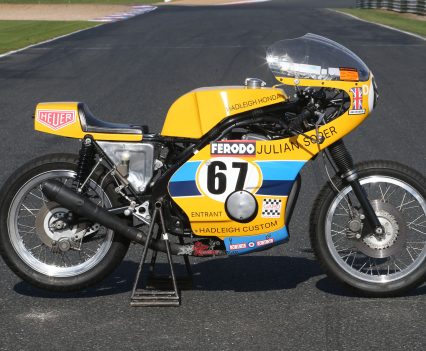
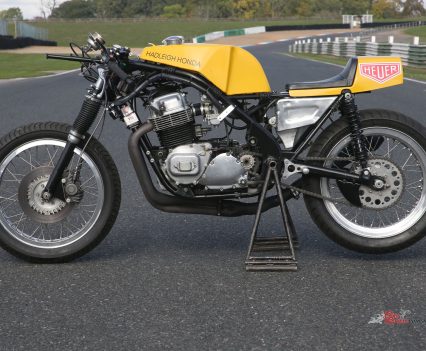
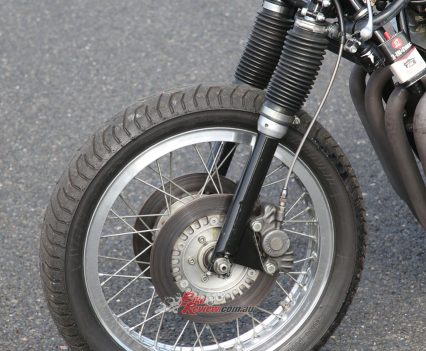
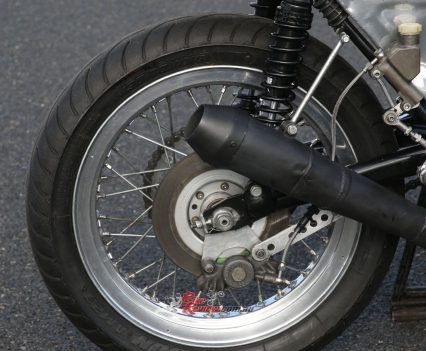
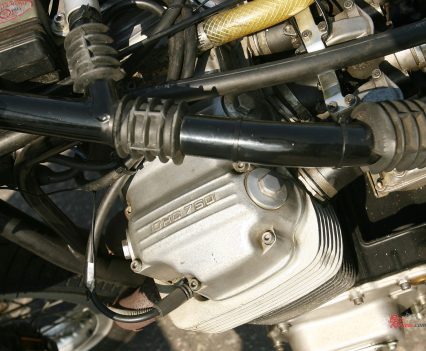
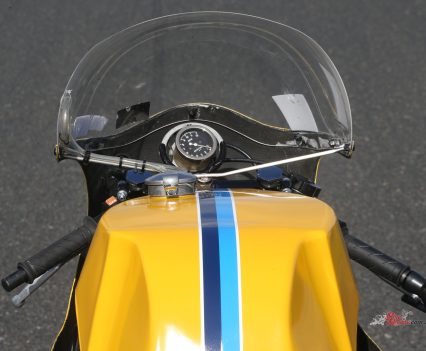
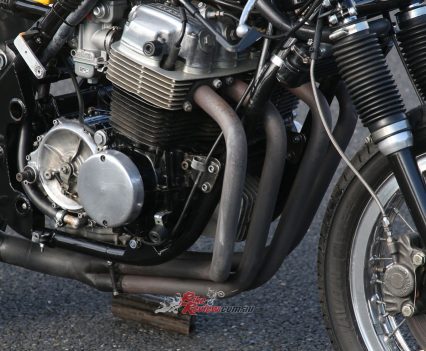
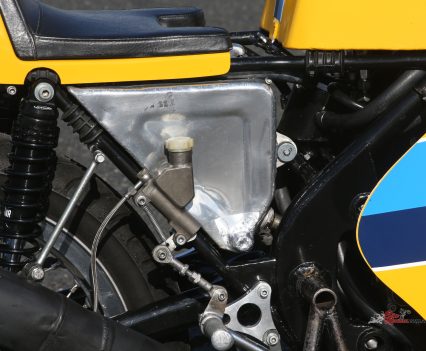
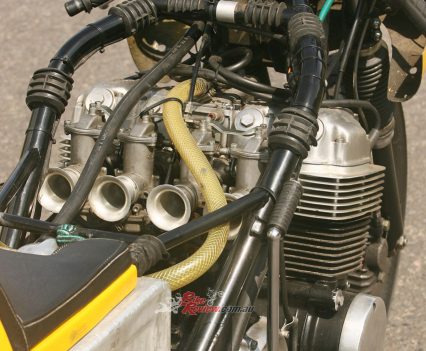
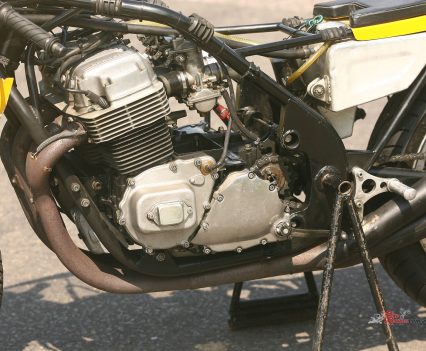
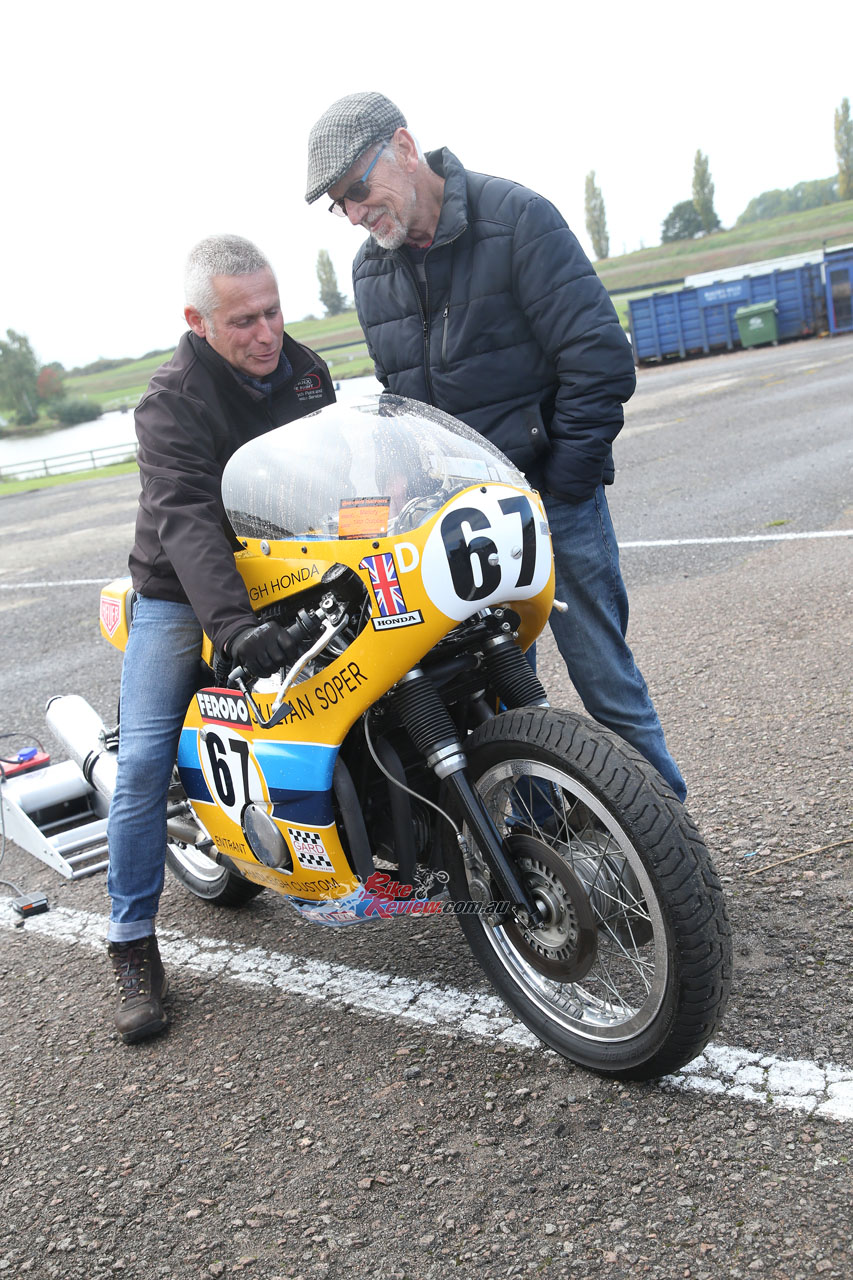
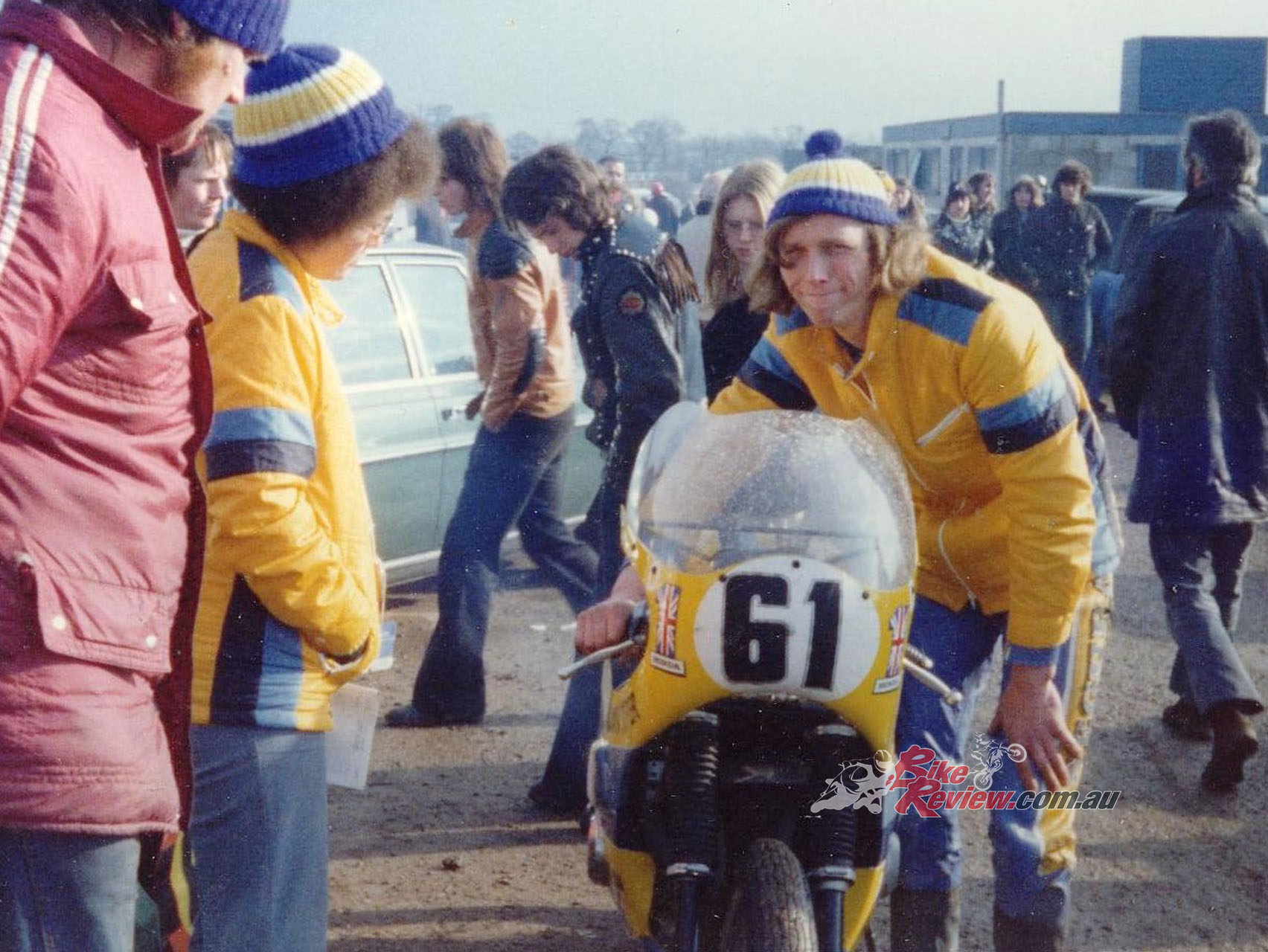
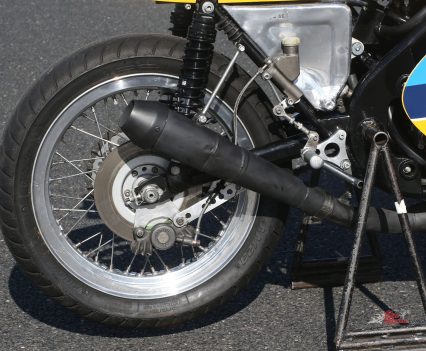
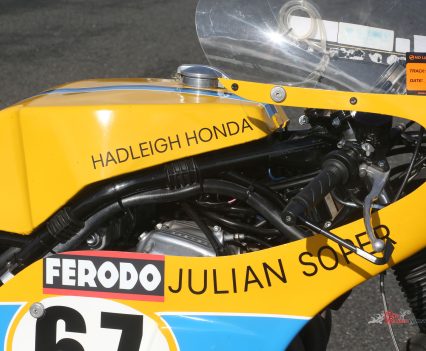
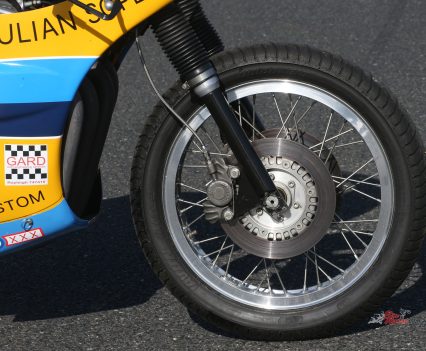
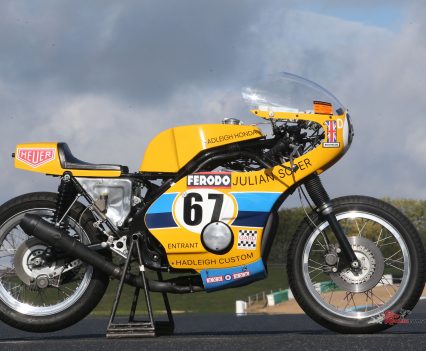
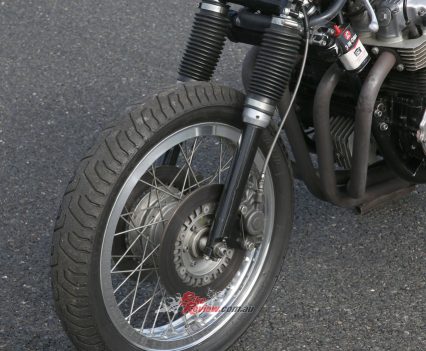
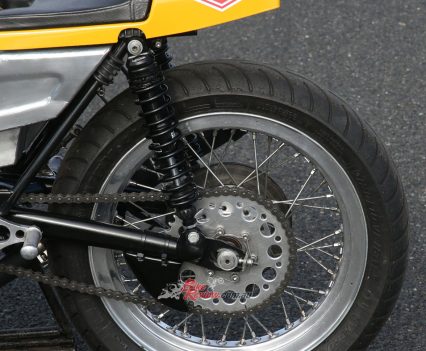
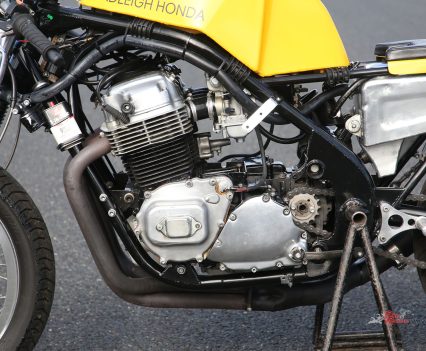
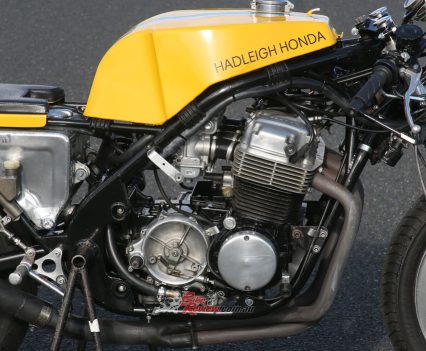
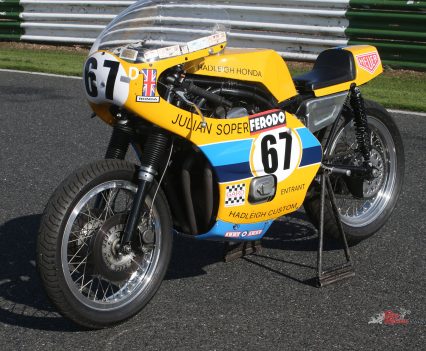
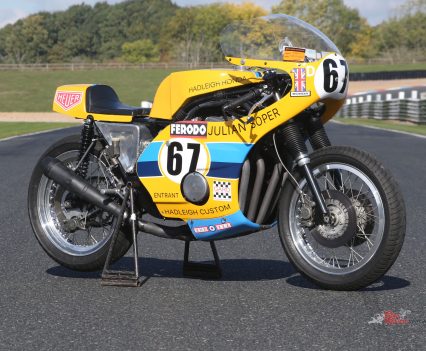
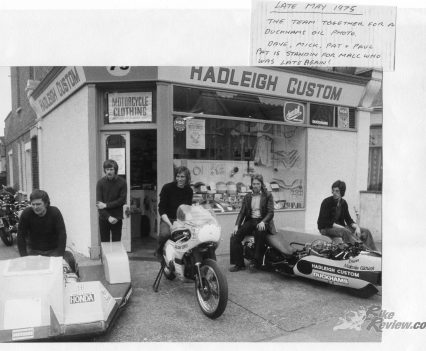
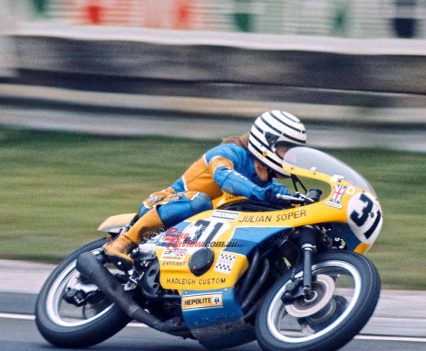
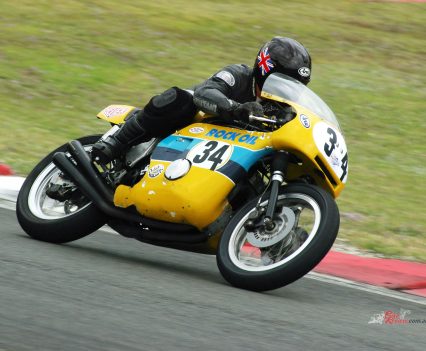
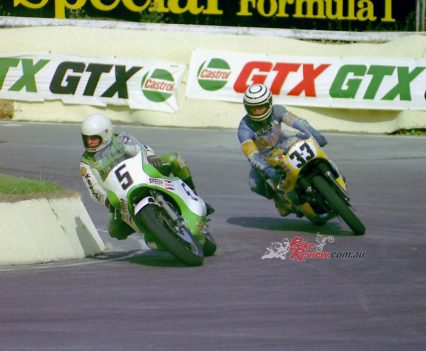
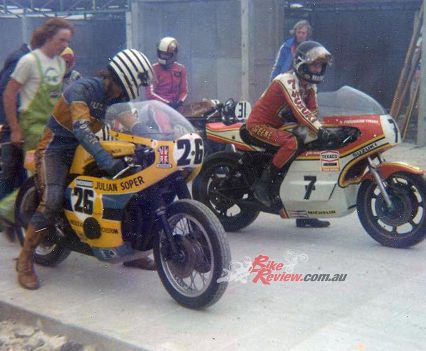
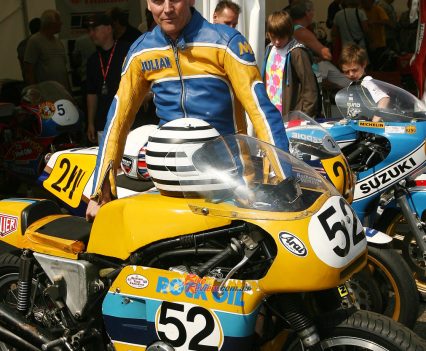
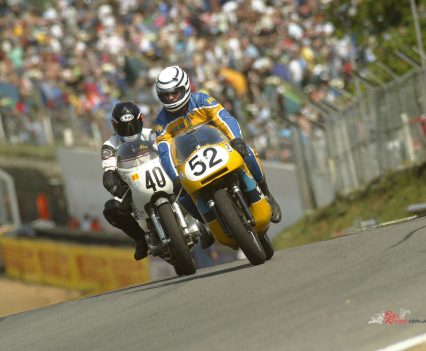
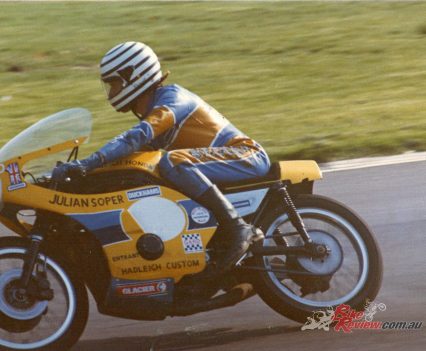
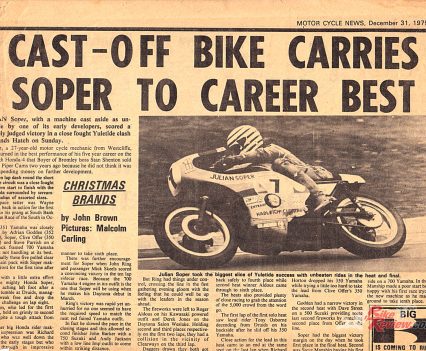
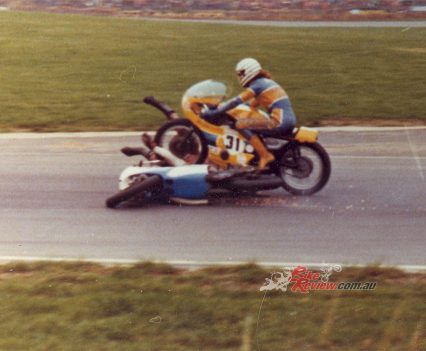
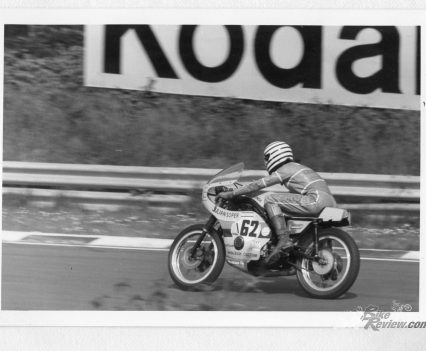
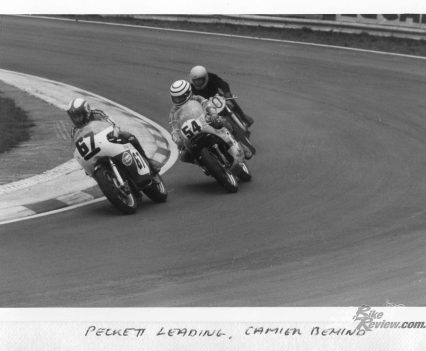
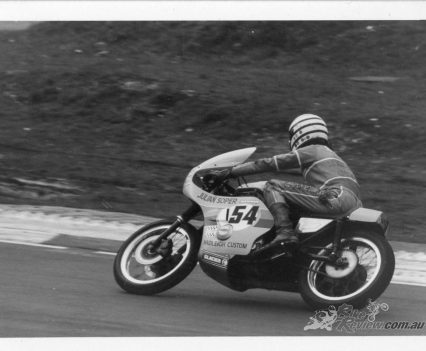
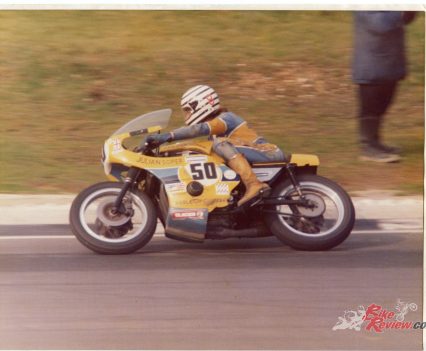
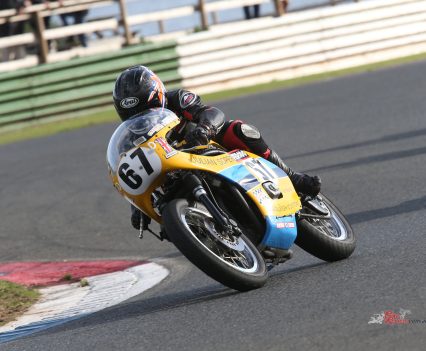
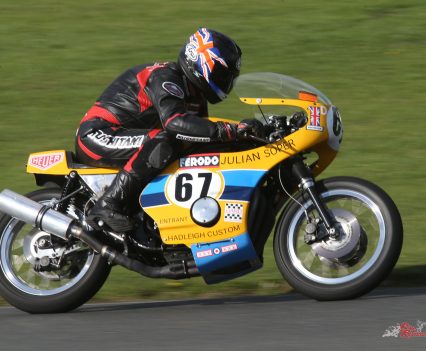
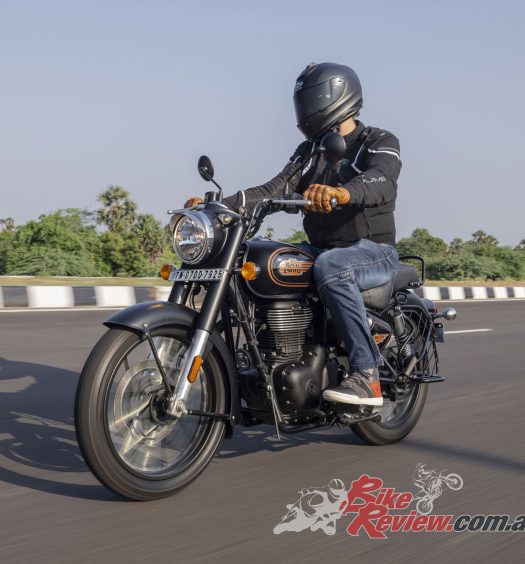
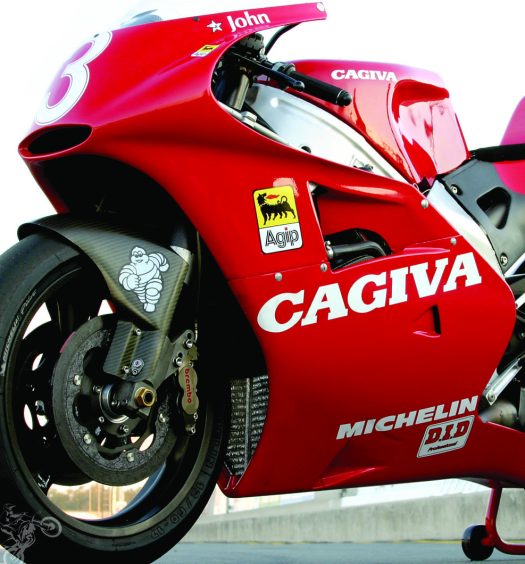

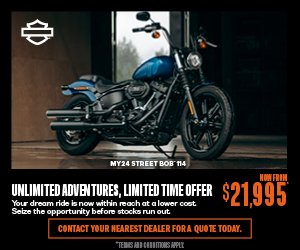
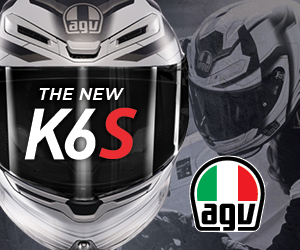
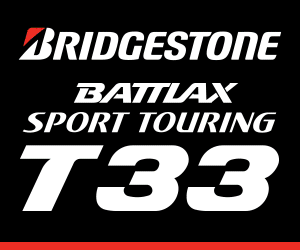



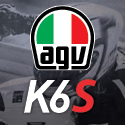





January 10, 2024
North, like many before/after him, let a mountain of money slip past by not producing more frames to fit the CB750 powerplant.